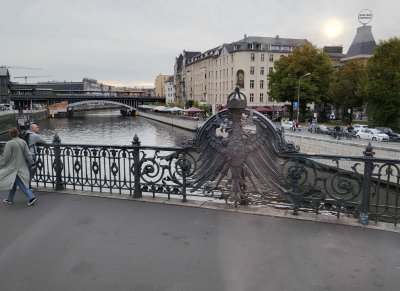
Crossing the Spree River in Berlin |
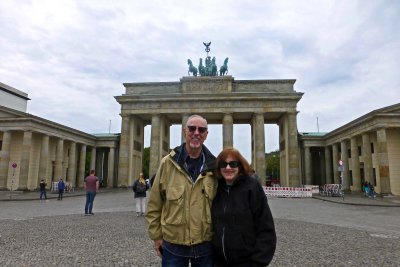
Visiting the Brandenburg Gate in Berlin, Germany |
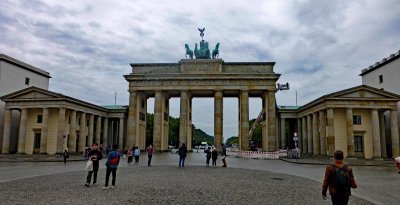
Brandenburg Gate (1788-91) was built on the orders of Prussian King Frederick William II |
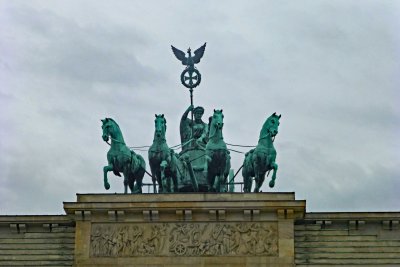
The 'Quadriga' depicts a statue of the goddess of victory driving a chariot pulled by four horses |
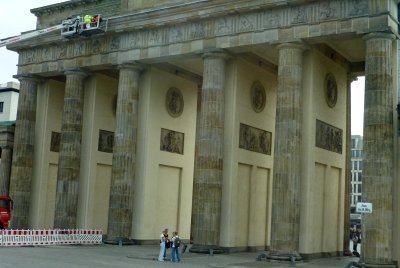
Relief sculptures inside the Brandenburg Gate |
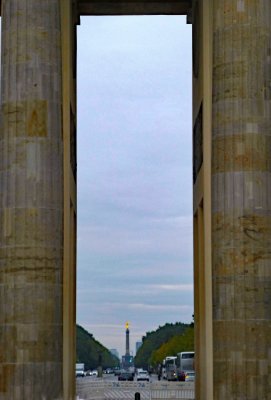
The Victory Column viewed from the Brandenburg Gate |
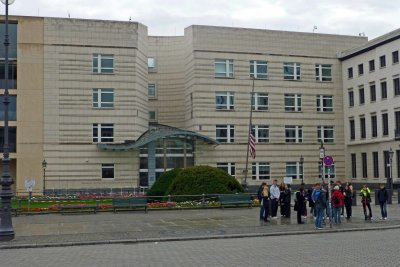
The United States Embassy is next to the Brandenburg Gate in Berlin |
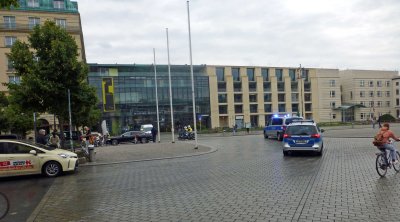
Lots of Polizei activity in Berlin today |
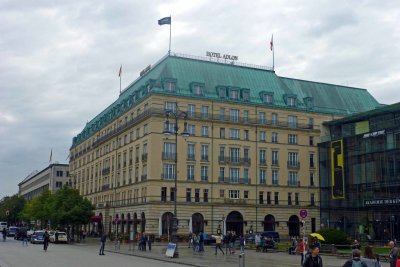
The Hotel Adlon (opened in 1907) is featured in many movies and is where Michael Jackson held his son out of a window |
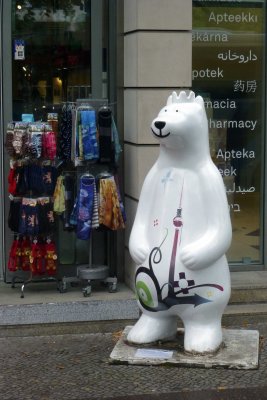
One of 500 'Buddy Bears' in Berlin, Germany |
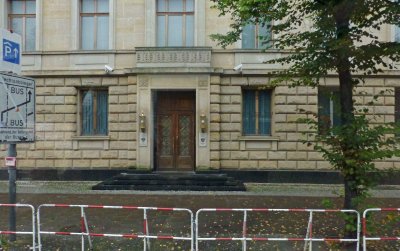
Barricades in front of the Russian Embassy in Berlin |
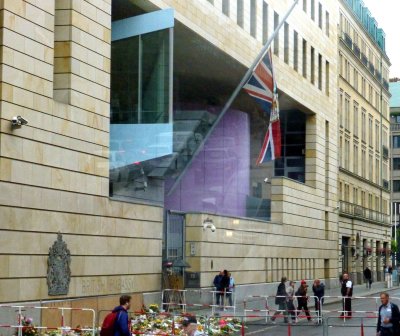
Memorial flowers in memory of Queen Elizabeth II in front of the British Embassy in Berlin |
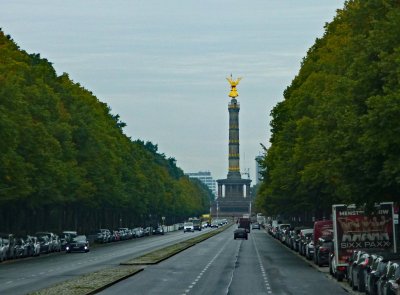
The Victory Column in Berlin is at the end of 17th of June Street |
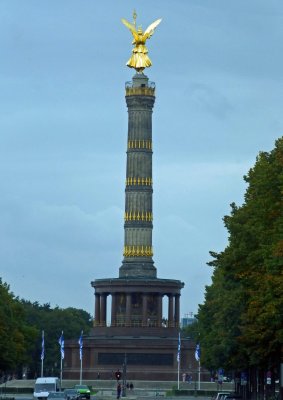
Victoria, the Roman goddess of victory, is referred to by Berliners as 'Chick on a Stick' |
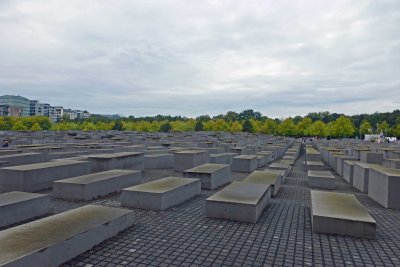
Memorial to the Murdered Jews of Europe 'represents a radical approach to the traditional concept of a memorial' |
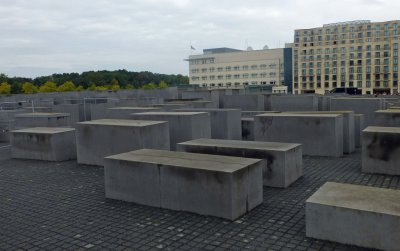
The Memorial to the Murdered Jews of Europe sits behind the United States Embassy |
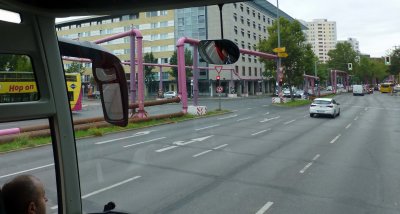
These colored pipes channel groundwater from construction sites into the Spree River |
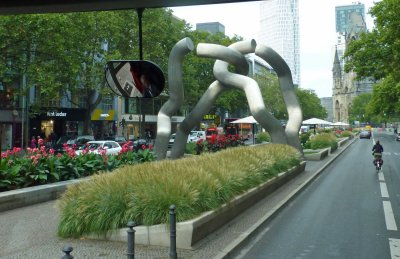
'Berlin' is a sculpture on the Tauentzienstrasse |
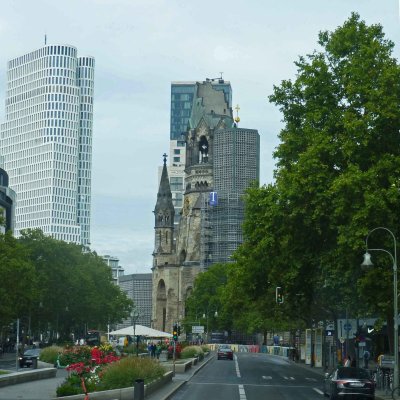
Approaching the Kaiser Wilhelm Memorial Church on the Tauentzienstrasse in Berlin |
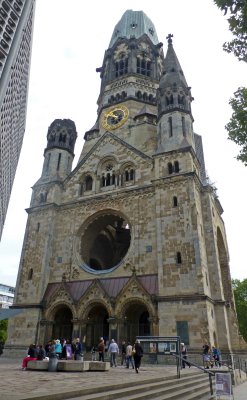
The Kaiser Wilhelm Memorial Church was originally built in the 1890s |
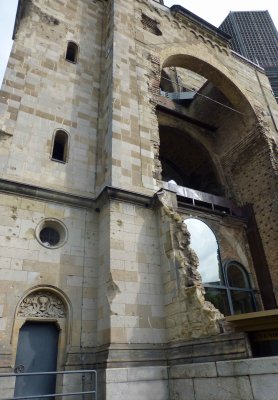
The Kaiser Wilhelm Memorial Church damage from a bombing raid in 1943 was retained as a memorial |
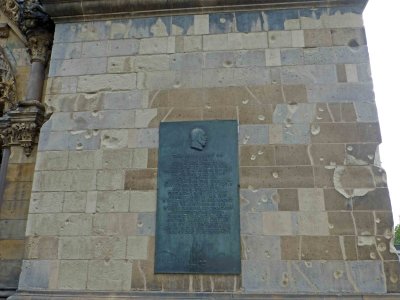
Bullet holes in Kaiser Wilhelm Memorial Church |
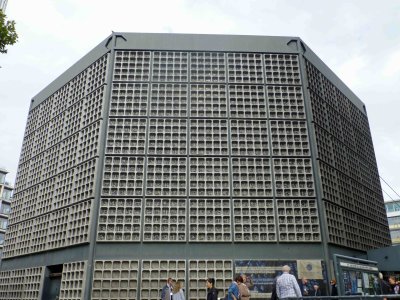
The new Kaiser Wilhelm Memorial Church in Berlin (completed 1961) |
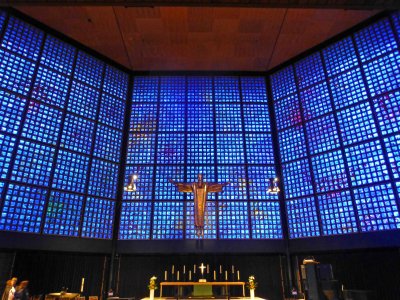
Inside the new Kaiser Wilhelm Memorial Church in Berlin |
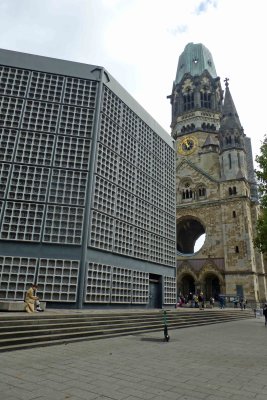
New & old Kaiser Wilhelm Memorial Churches |
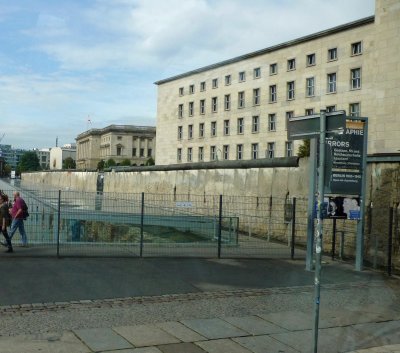
Preserved section of the Berlin Wall with drab East German buildings in the background |
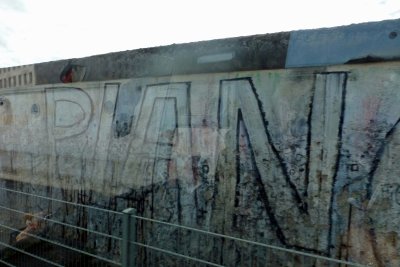
A section of the Berlin Wall |
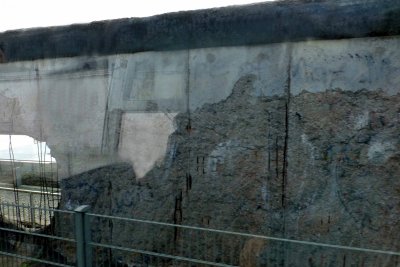
The last remaining section of the Berlin Wall outside of museums is deteriorating |
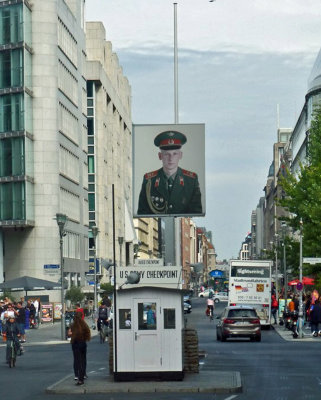
Photo of Russian Soldier looking west from Checkpoint Charlie in Berlin |
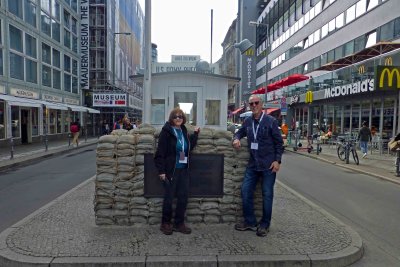
On the East German side of Checkpoint Charlie in Berlin |
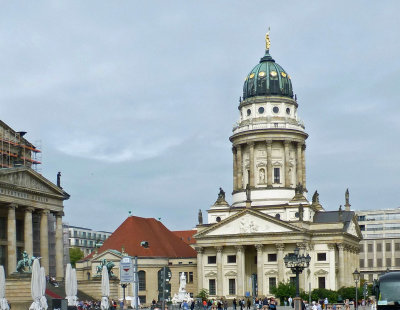
The 'German Church' (1708) in Gendarmenmarkt in Berlin |
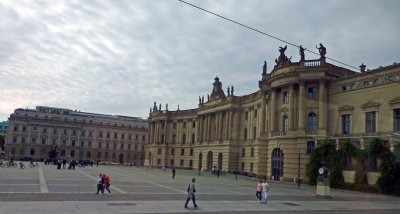
Bebelplatz is a public square in the central Mitte district of Berlin |
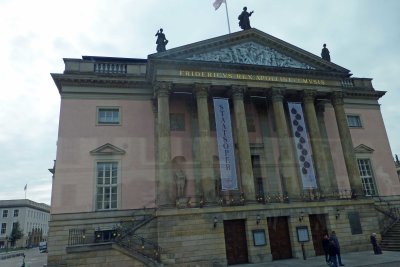
Berlin State Opera (1742) |
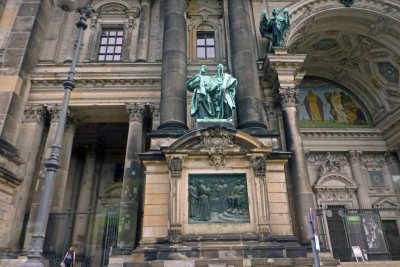
The Berlin Cathedral was built 1894 - 1905 |
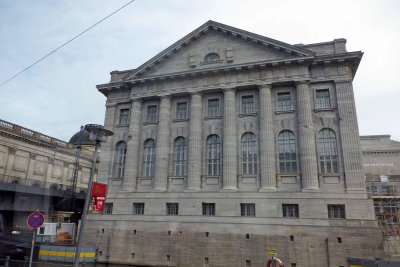
One of five museums on Museum Island in Berlin |
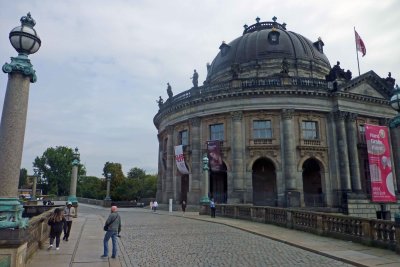
The Bode Museum on Museum Island in Berlin |
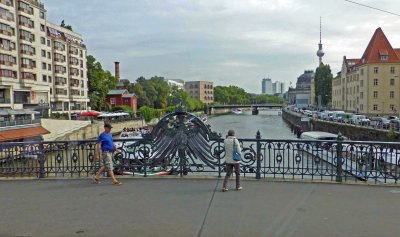
The Spree River with Berlin Television Tower (built by East Germany) in the distance |
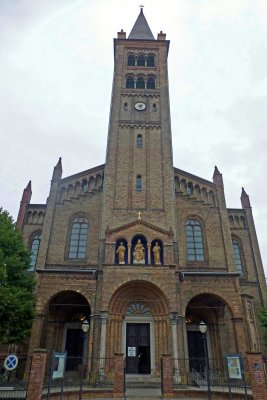
The Church of St Peter and Paul (1870) in Potsdam, Germany |
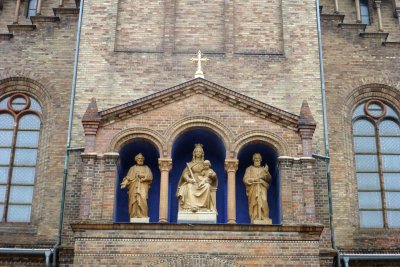
Statues on the Church of St Peter and Paul in Potsdam, Germany |
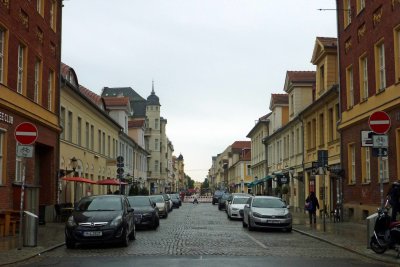
Downtown Postsdam, Germany |
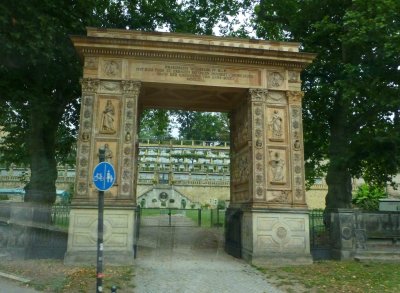
Triumphal Gate (1851) in Potsdam, Germany |
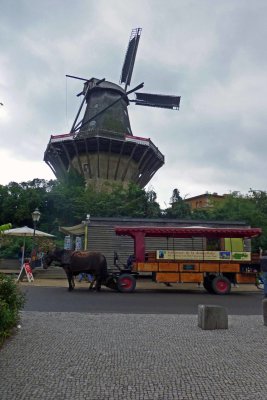
Historic Mill of Sanssouci in Potsdam, Germany |
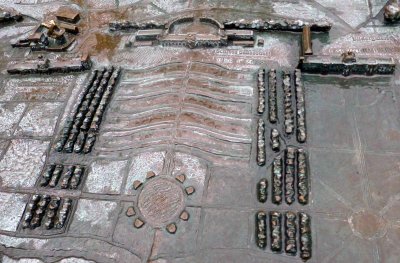
Sanssouci Palace was built by Prussian King Frederick the Great as his summer palace |

Sanssouci Palace was built 1745-1747 |
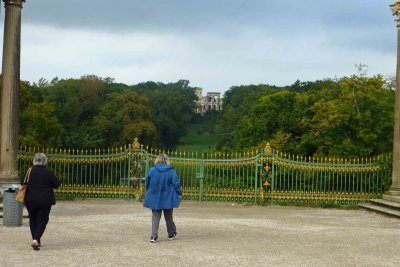
View from courtyard of Sanssouci Palace |
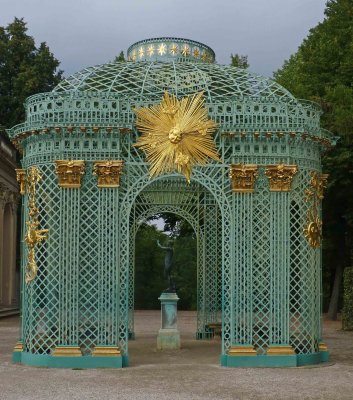
Trellised Gazebo at Sanssouci Palace |
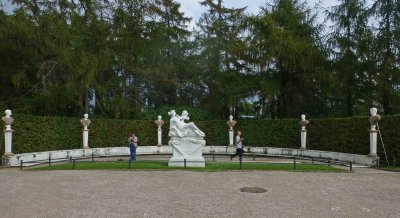
King Frederick the Great is buried here with his 11 beloved greyhounds |
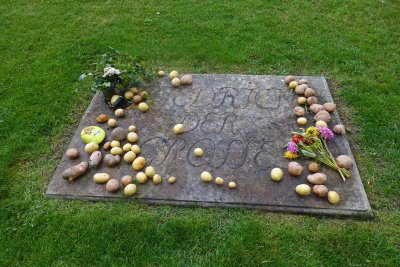
Frederick the Great introduced the potato to Germany and they are left on his grave as a tribute |
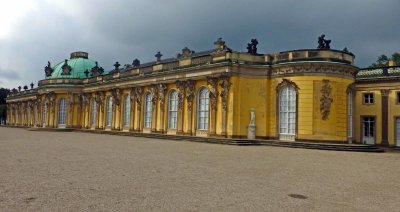
After World War II, the palace became a tourist attraction in East Germany |
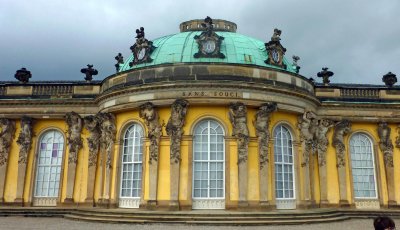
King Frederick's personal taste was so great that its style is characterised as 'Frederician Rococo' |
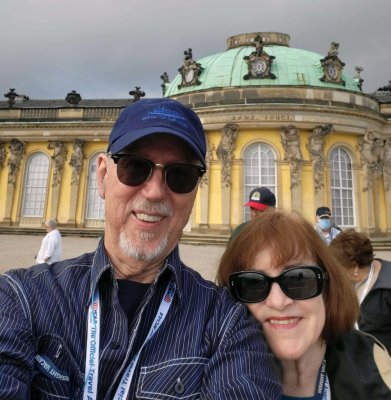
Bill & Susan at Sanssouci Palace in Potsdam |
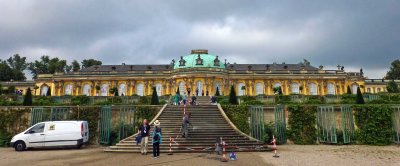
View of Sanssouci Palace from the first level of the garden terrace |
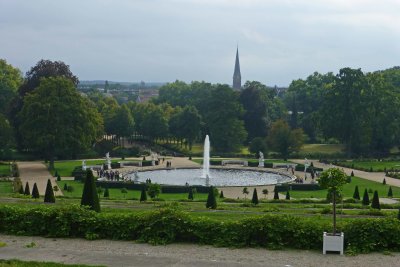
Sanssouci Palace Fountain |
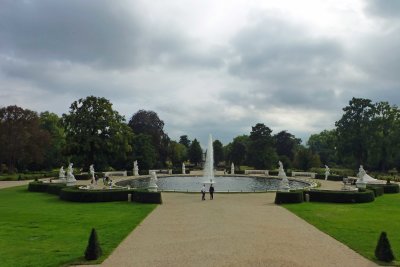
Statues around Sanssouci Palace Fountain |
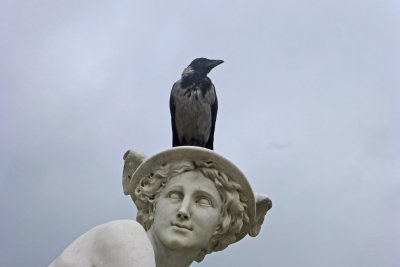
Bird on the winged Mercury statue |
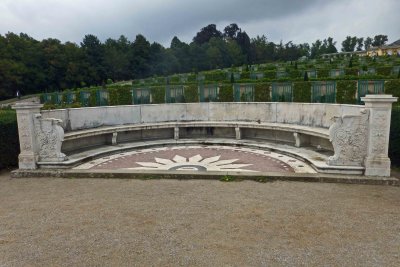
One of the benches near the Sanssouci Fountain |
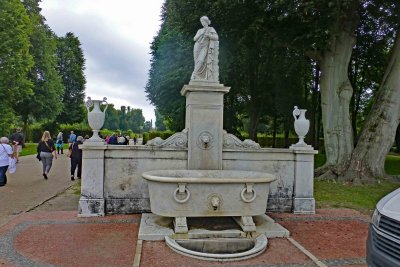
Fountain leaving Sanssouci Palace |
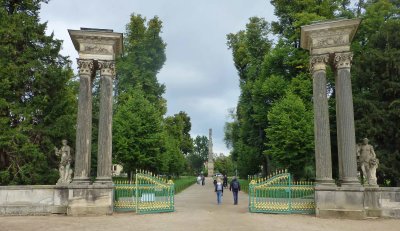
Exit gates from Sanssouci Palace |
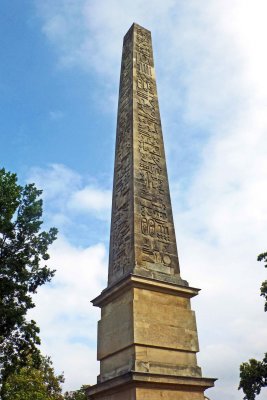
Obelisk erected at the eastern entrance to Sanssouci Park in 1747 |
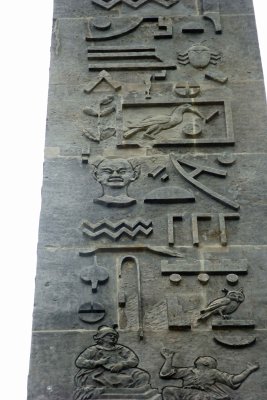
Hieroglyphs are purely created using artistic vision of Georg Wenzeslaus von Knobelsdorff |
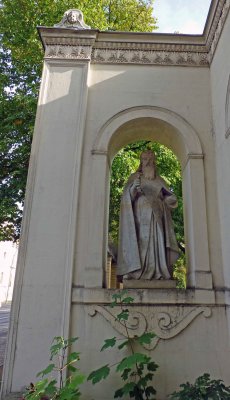
Statue at the entrance to the Peace Church on the grounds of Sanssouci Park |
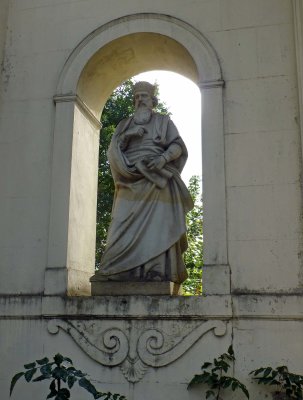
Statue at the entrance to the Peace Church on the grounds of Sanssouci Park |
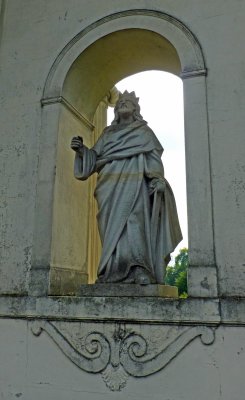
Statue at the entrance to the Peace Church on the grounds of Sanssouci Park |
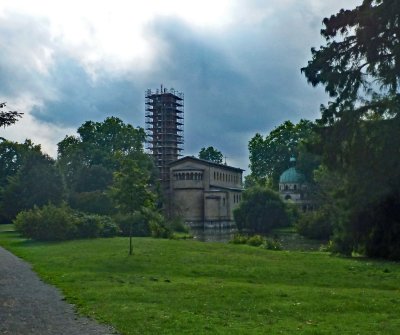
The Protestant Church of Peace is the Marly Gardens in the palace grounds of Sanssouci Park |
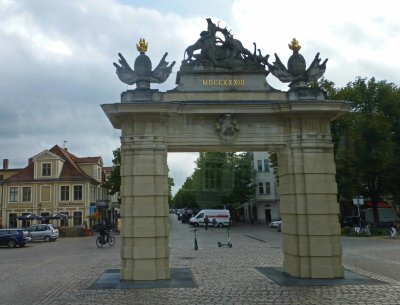
The Jagertor is the oldest surviving city gate in Potsdam (1733) |
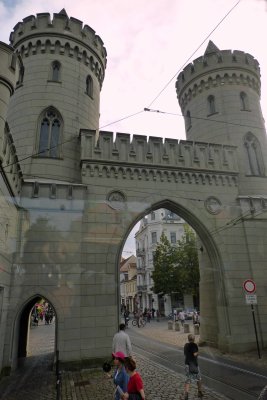
Nauen Gate(1755) is one of the three preserved gates of Potsdam, Germany |
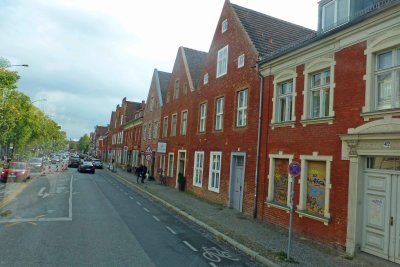
The Dutch Quarter in Potsdam, Germany |
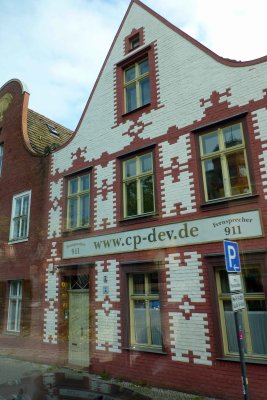
Architecture in the Dutch Quarter of Potsdam |
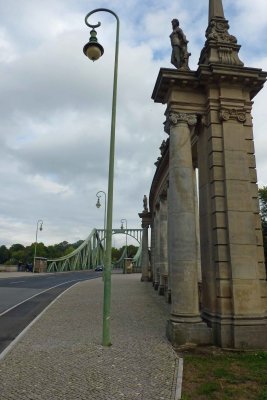
The Potsdam (former East German) side of the Glienicke Bridge -- also known as 'The Bridge of Spies' |
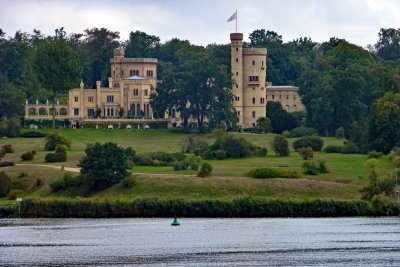
Babelsburg Palace (1836-49) on the Havel River across from Glienicke Bridge |
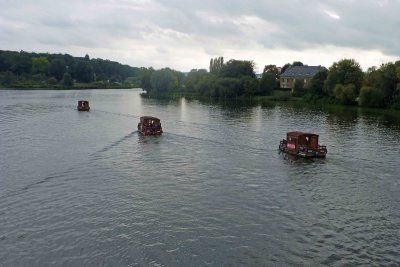
Houseboats on the Havel River viewed from 'The Bridge of Spies' |
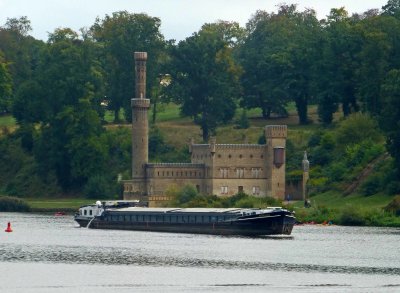
Steam-powered pump house (1841-1843) on the Havel River was built at the request of Frederick Wilhelm IV |
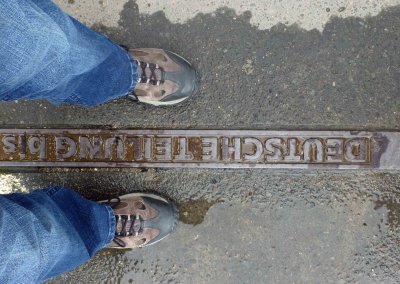
Mid-point of Glienicke Bridge with one foot in former East Germany and one foot in West Berlin |
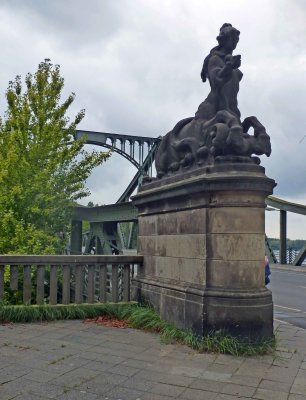
The West Berlin side of the Glienicke Bridge where Gary Powers was exchanged for a captured soviet spy |
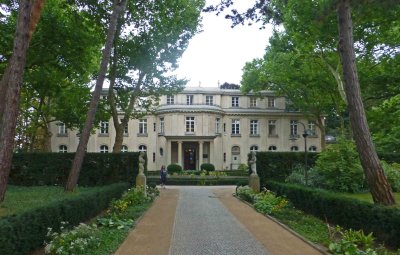
The Villa Marlier (1915) was the site of the infamous Wannsee Conference |
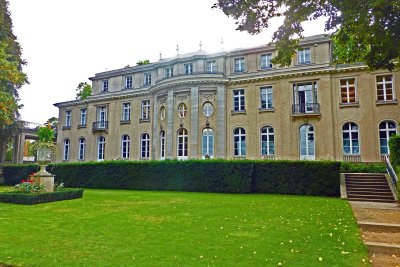
Wannsee Conference was a meeting of 15 Nazi & SS officials to finalize plans for the deportaation and murder of European Jews |
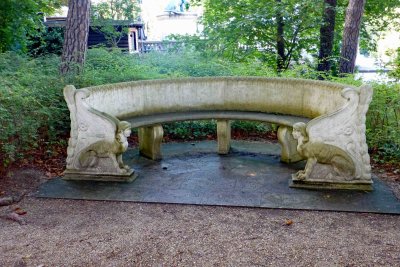
Bench on the property of the site of the Wannsee Conference |
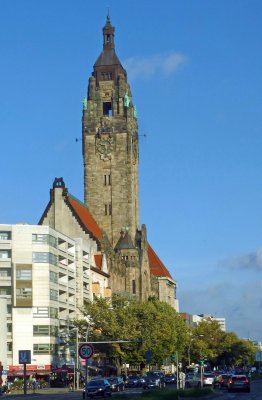
Charlottenburg Town Hall (1895-1905) is an administrative center for a borough in Berlin |
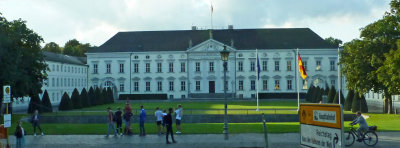
Bellevue Palace, in Berlin's Tiergarten district, has been the official residence of the President of Germany since 1994 |
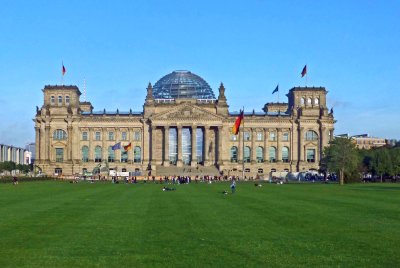
The Reichstag (1894) is a historic government building in Berlin which houses the lower house of Germany's parliament |
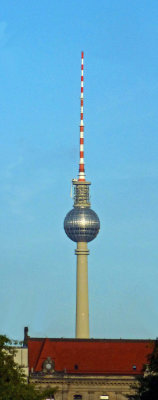
The Berlin TV Tower was constructed between 1965 and 1969 by the East German government as a symbol of Communist power |
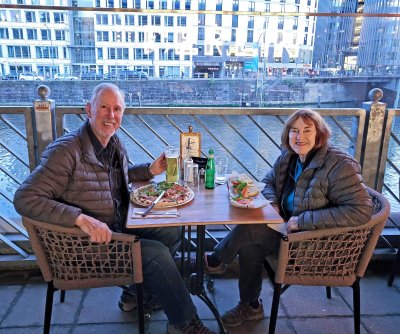
Dinner on the Spree River in Berlin |
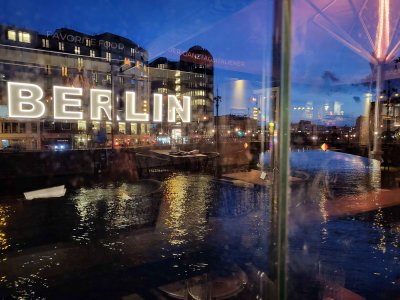
Our view of the Spree River at dinner in Berlin |
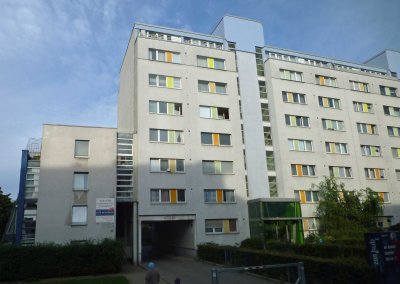
Typical East German concrete construction |
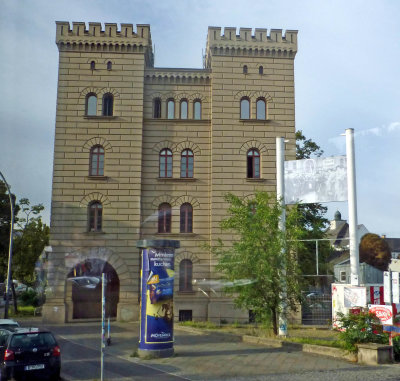
Guard Dragoon Barracks (1854) has been used as a tax office since 1923 |
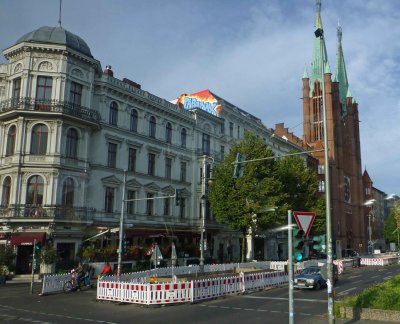
Block of flats built in 1868 in front of the Church of Saint Boniface in Berlin |
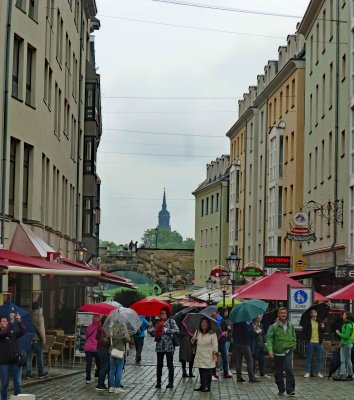
Arriving in Dresden, Germany on a rainy day |
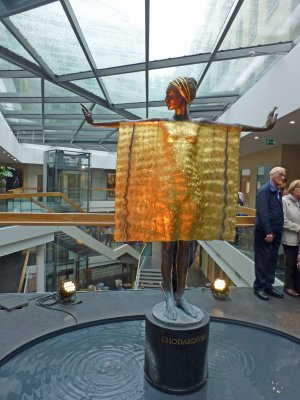
Tour guide took us into the QF Passage Mall in Dresden, Germany to get out of the rain |
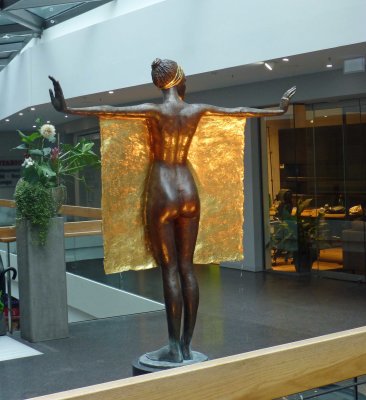
Back of statue in QF Passage Mall in Dresden, Germany |
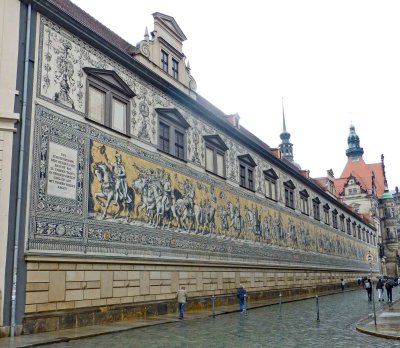
Procession of Princes (rulers of Saxony) in Dresden was originally painted between 1871 & 1876 |
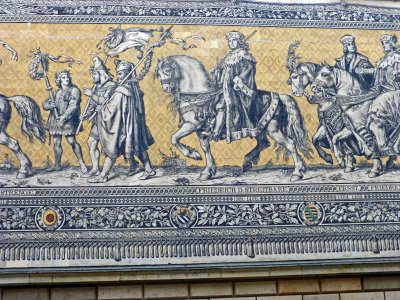
Between 1904 and 1907 the 335 ft wall was covered with 23,000 Meissen porcelain tiles to make it weatherproof |

Mural displays the ancestral portraits of the 35 margraves, electors, dukes & kings of the House of Wettin between 1127 and 1904 |
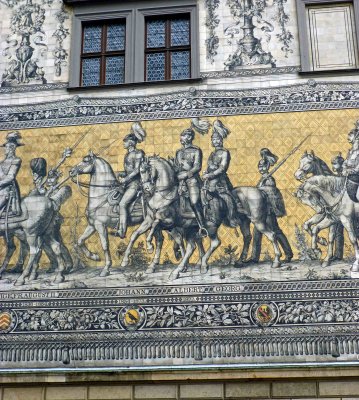
Only minimal damage to the porcelain tiles resulted from the February 13, 1945 bombing of Dresden |
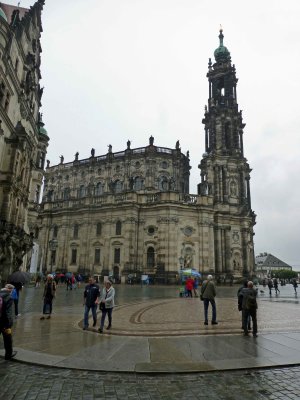
Dresden Cathedral was founded in 1739 and completed in 1751 |
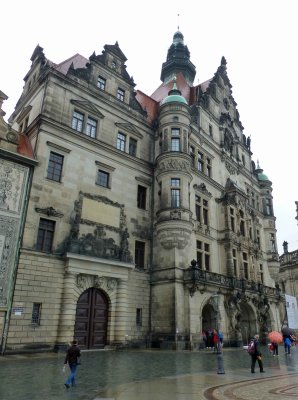
The Georgentor (1530-35) is the original city exit from Dresden to the Elbe bridge |
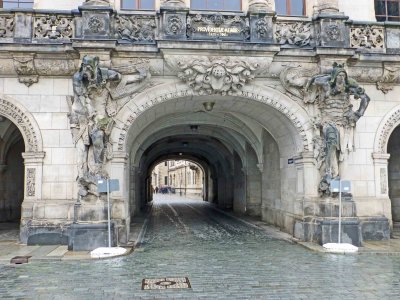
Stone figures on the Georgentor guard this entrance to the Desden Castle |
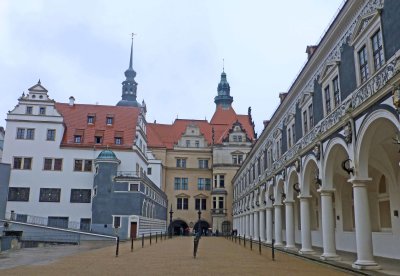
Stall Courtyard in Dresden Castle built in 1586 and used for tournaments |
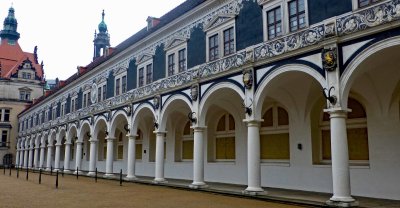
Stall Courtyard is now used for cultural events like the Medieval Christmas Market |
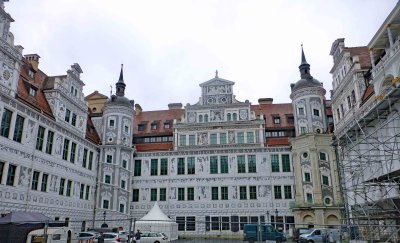
Restoration of Dresden Castle began in 1960 and is still ongoing |

Windows in this tower are slanted to match the angle of the spiral staircase |
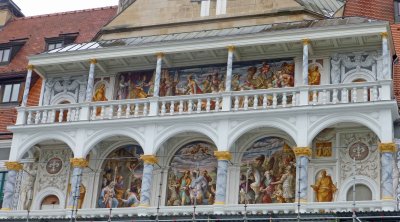
Restored frescoes in Dersden Castle |
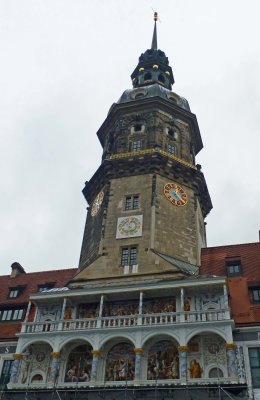
The clock tower of the Dresden Castle was finished in 1676 and afforded watchmen an unobstructed view of the city |
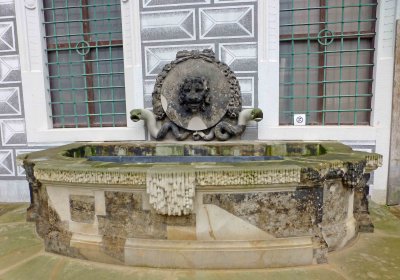
Fountain in the courtyard of Dresden Castle |
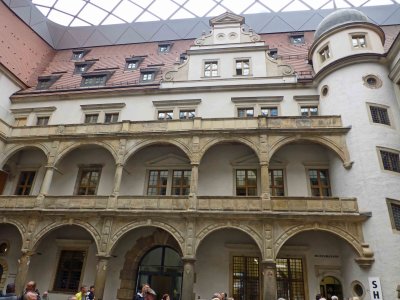
Small courtyard in Dresden Palace has been covered and is used for ticket sales for museums |
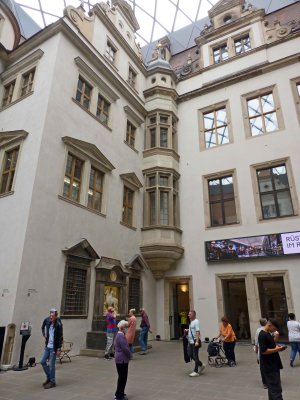
Dresden castle currently houses five museum sections |
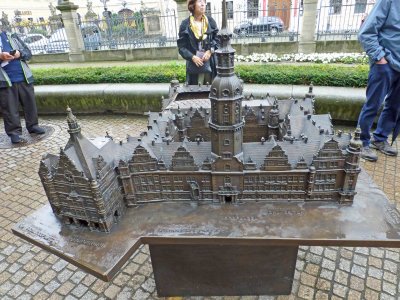
Bronze model of Dresden Castle |
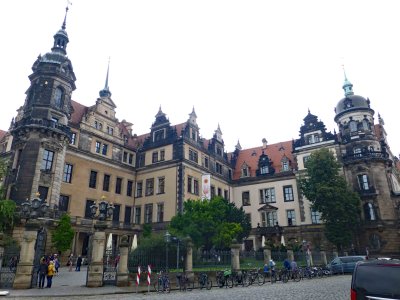
Back entrance to Dresden Castle |
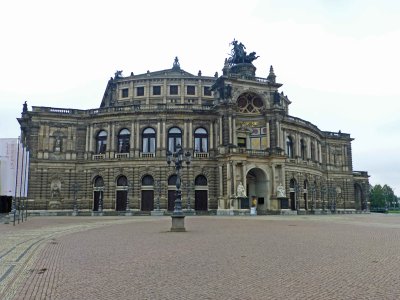
The Semperoper (178) is an opera house, a concert hall, and a ballet theater |
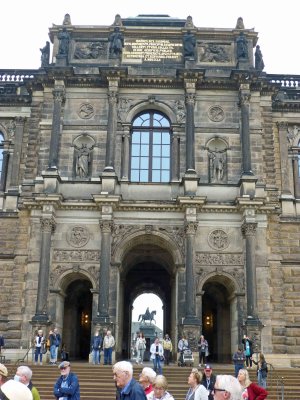
The Zwinger (1728) is a palatial complex with gardens in Dresden |
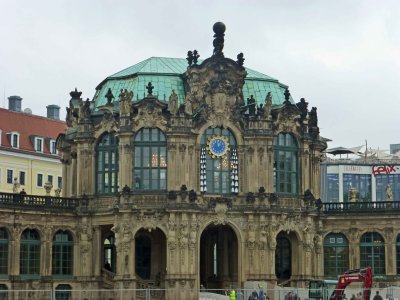
The Zwinger's Carillon pavilion contains Meissen porcelain bells that play every 15 minutes |
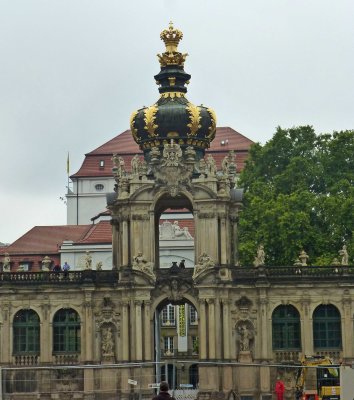
The Kronentor is an 18th-century Baroque gateway and the main entrance to the Zwinger in Dresden |
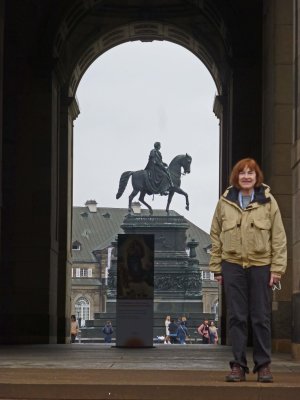
A statue of King John of Saxony from 1854-73 outside the Zwinger in Dresden |
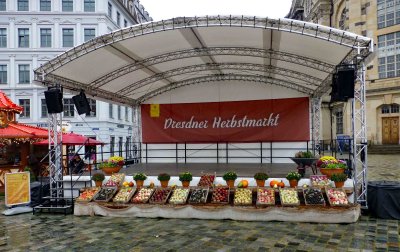
Dresden's Autumn Market is going on |
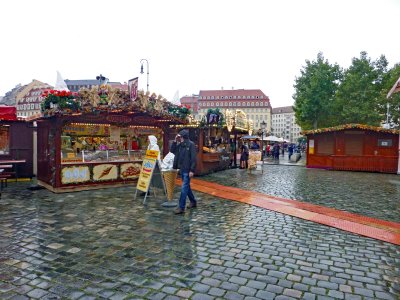
Autumn Market is held on Old Market Square in Dresden |
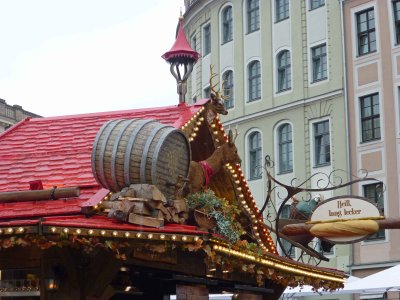
Sign says hot, long, delicious |
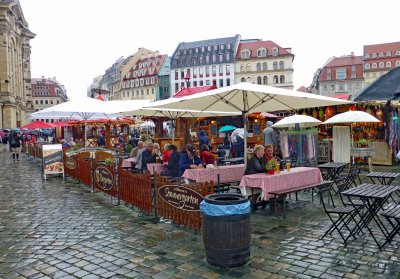
Umbrellas provided shelter for our beer, brats, and french fry lunch |
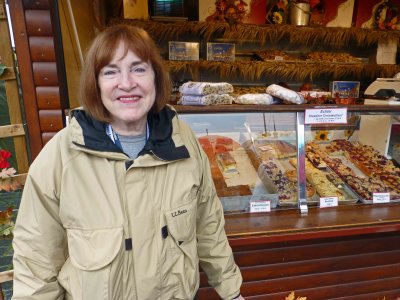
We enjoyed dessert from this pastry kiosk |
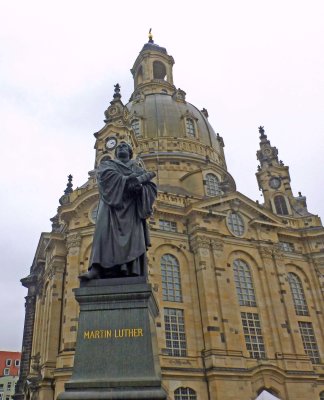
Martin Luther is important in Dresden as Dresden was given the honorary title 'Motherland of the Reformation' |
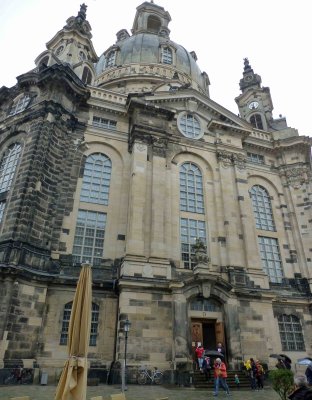
Dresden's Church of Our Lady (1743) is a Lutheran church rebuilt using 3,800 orginal stones after its destruction in WWII |
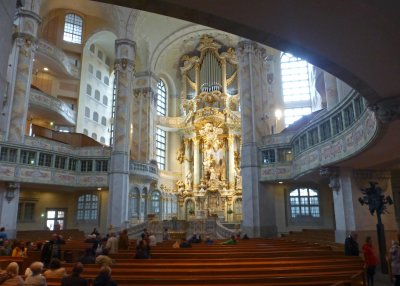
Inside Dresden's Church of Our Lady (Frauenkirche) |
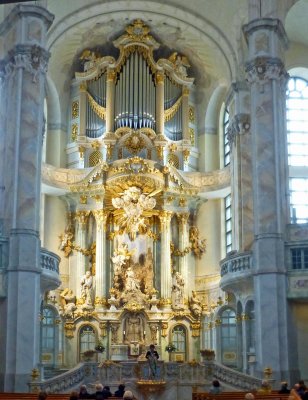
Two thousand pieces of the original altar were cleaned and incorporated into the new structure |
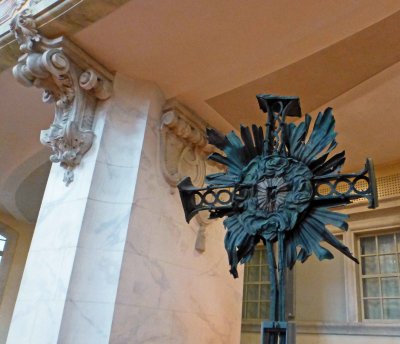
This is the original cross from the Frauenkirche’s dome after it was destroyed during WWII |
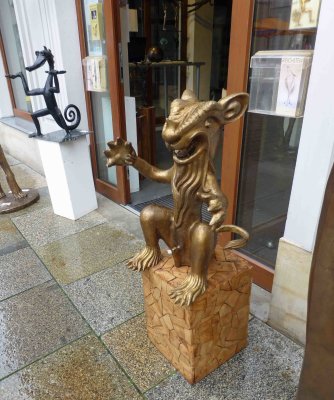
Interesting statue in front of Dresden shop |
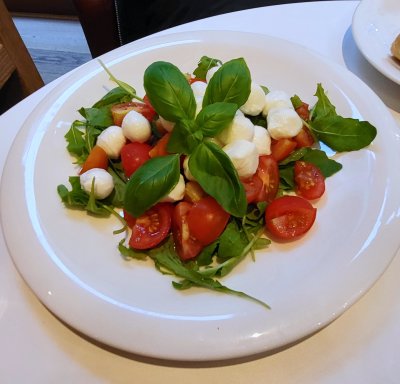
Interesting Caprese Salad in Dresden |
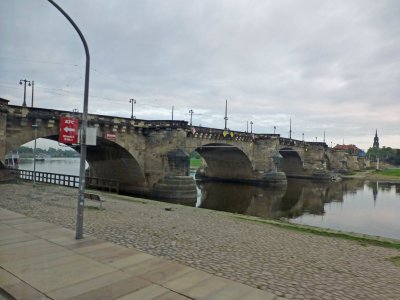
Augustus Bridge (1731) crosses the Elbe River in Dresden, Germany |
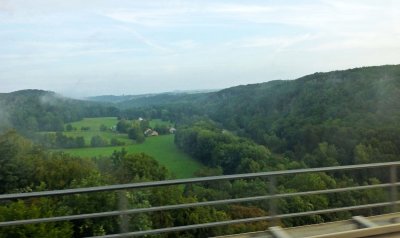
Driving from Dresden to Weimar, Germany |
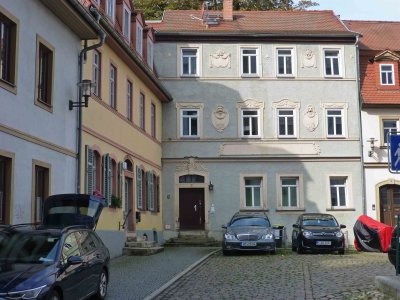
Building in Weimar, Germany |
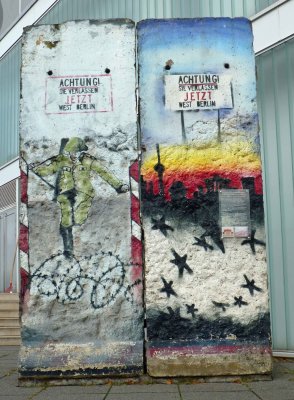
Original pieces of the Berlin Wall in Weimar, Germany |
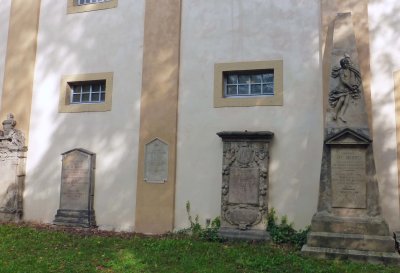
Burials in St. James's Churchyard is the oldest extant burial ground in Weimar going back to the 12th Century |
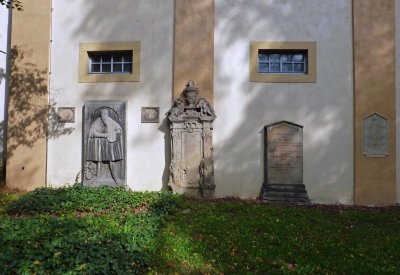
Lucas Cranach the Elder (an artist associated with the Reformation) is buried here |
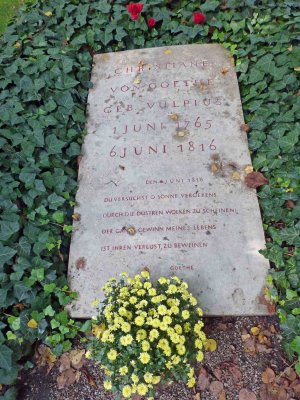
Johann Wolfgang von Goethe's wife is buried in St. Jame's Churchyard in Weimar |
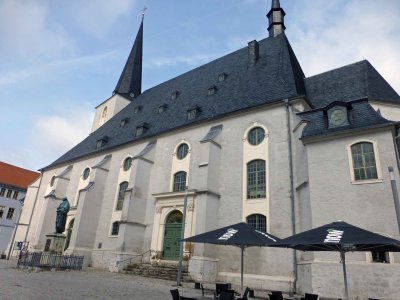
Weimar Church of St. Peter and Paul (built in 1500) sits on the foundation of a church from 1249 |
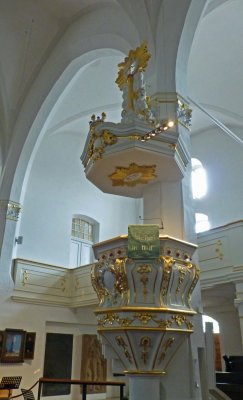
Inside the Church of St. Peter and Paul in Weimar |
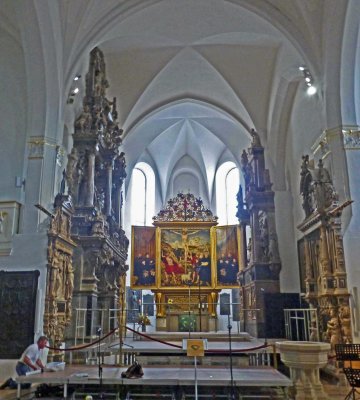
The Altar in the Church of St. Peter and Paul |
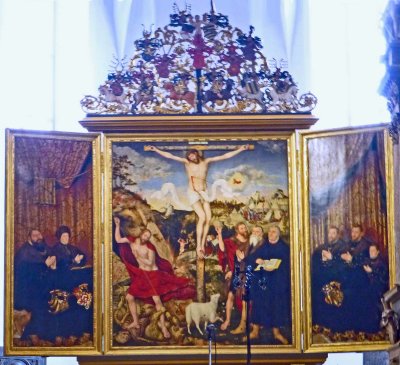
The triptych (1555) in the Church of St. Peter and Paul has been hailed as 'the single most important visual monument of German |
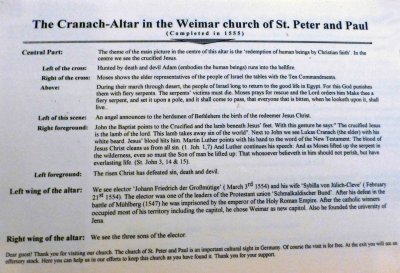
Explanation of the triptych started by Lucas Cranach the Elder in 1552 and completed by his son after his father's death |
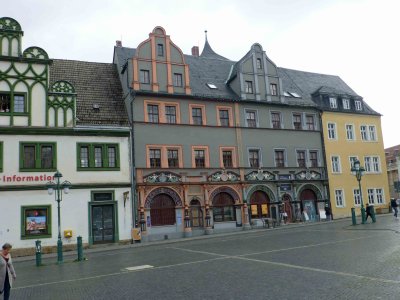
Historic Market Square in Weimar, Germany |
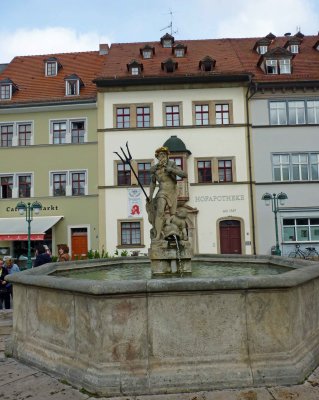
Neptune Fountain in front of pharmacy operating since 1567 in Weimar, Germany |
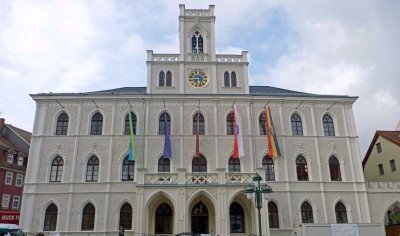
The city hall of Weimar was built in 1841 and has a Glockenspiel in the tower with Meissen porcelain bells |
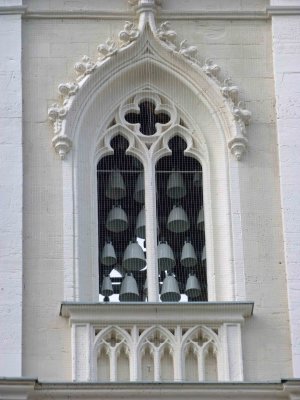
Meissen porcelain bells in the Glockenspiel at Weimar City Hall |
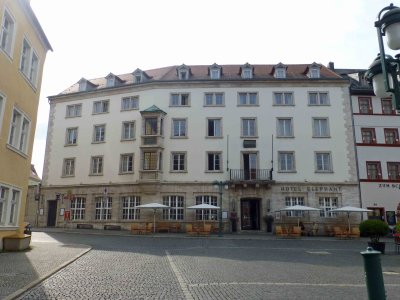
The balcony on Hotel Elephant in Weimar was outside Hitler's apartment where he came out to address cheering crowds |
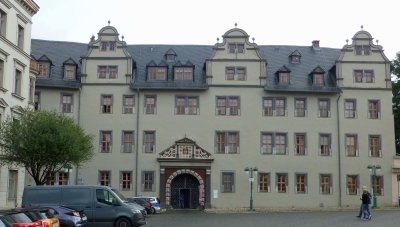
The Red Castle in Weimar was built from 1574 to 1576 and now contains a research library |
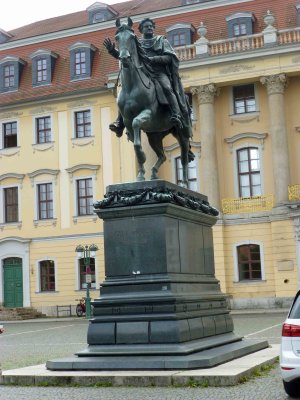
Karl August was the sovereign Duke of Saxe-Weimar and of Saxe-Eisenach |
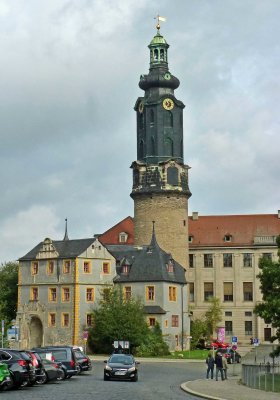
Weimar Castle has been developed from a 10th Century moated castle over 500 years |
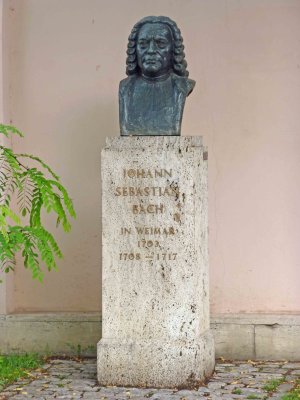
Johann Sebastian Bach shaped the Weimar music scene in an exceptional way |
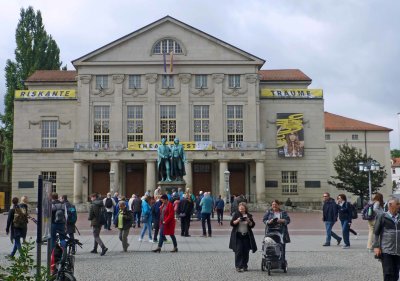
German National Theatre in Weimar is one of the oldest theatres in Germany dating to the 18th Century |
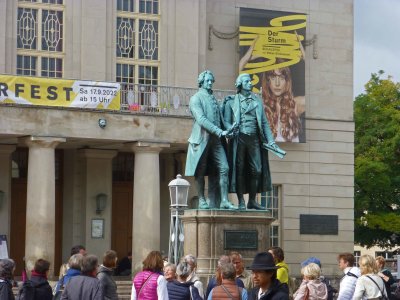
Johann Wolfgang Goethe and Friedrich Schiller are probably the two most revered figures in German literature |
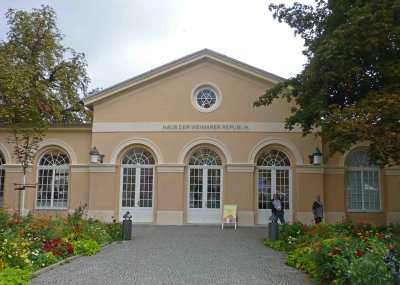
House of the Weimar Republik is the site of the constituent assembly that established Germany’s government from 1919-1935 |
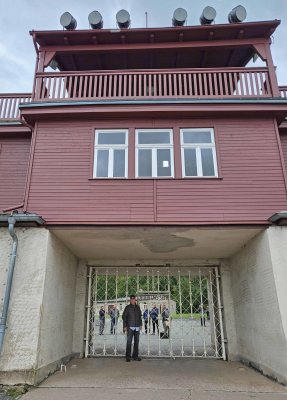
Entering the gate at Buchenwald Concentration Camp, Germany |
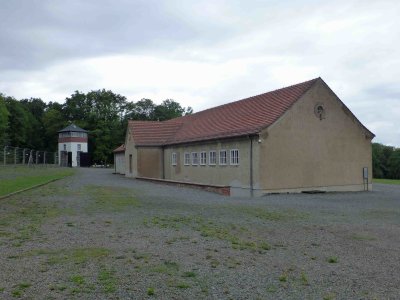
Inmates' Canteen and Guard Tower at Buchenwald Concentration Camp |
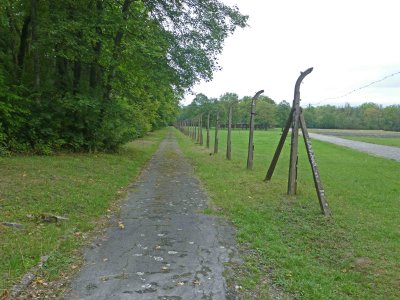
The 3 km Guard Path around Buchenwald was patrolled by SS Guards |
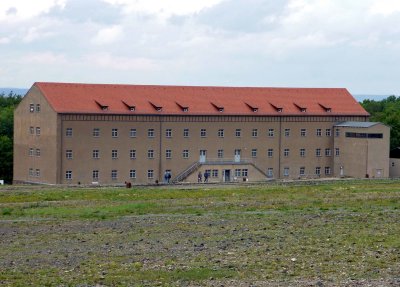
Buchenwald Barracks where medical experiments were conducted resulting in hundreds of deaths |
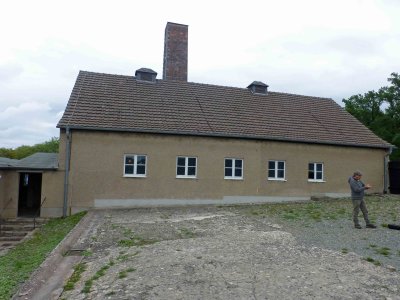
The Buchenwald Crematorium |
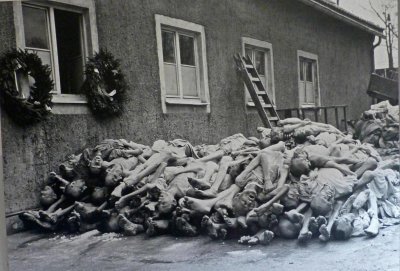
Photo taken by a US Army SergeantI on April23, 1945 of bodies piled outside the Buchenwald Crematorium |
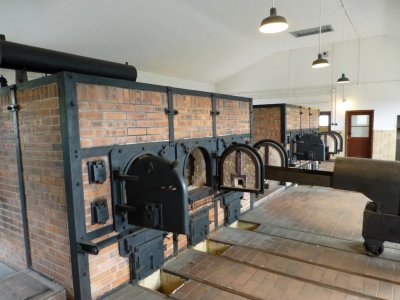
Crematory ovens were installed between 1940 and 1942 |
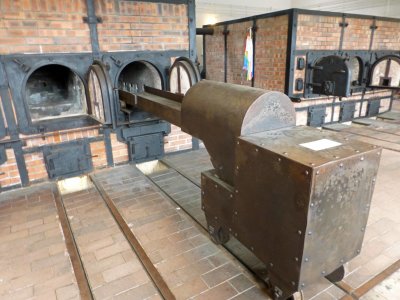
Ovens were designed so several corpses could be burned simultaneously without interruption between loads |
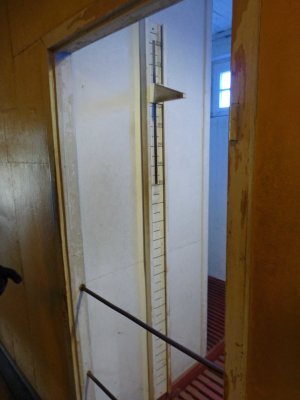
Inmates were told to stand here to be measured and then shot in the back of the head |
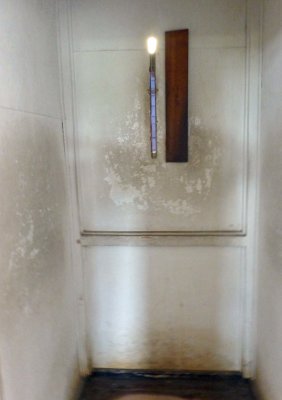
Guards shot inmates through this slit behind the measuring stick to avoid seeing their faces |
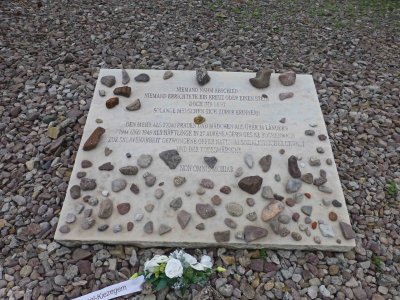
A memorial commemorating the more than 27,000 women and girls who died as a result of slave labor in the Buchenwald subcamps |
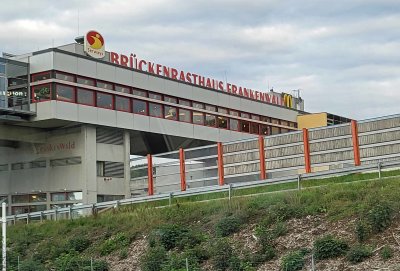
Dinner stop along the Autobahn in Germany |
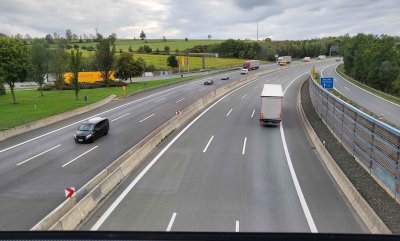
Our view at dinner above the Autobahn |
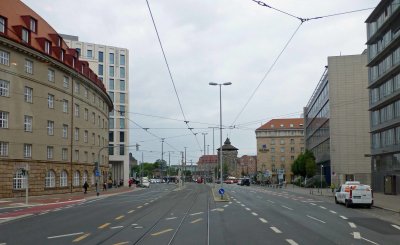
Arriving in Nuremberg, Germany |
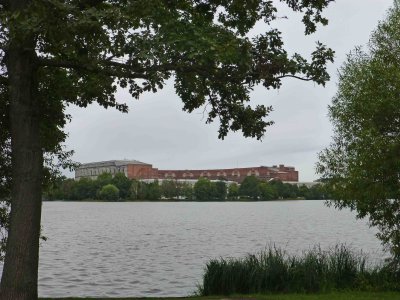
The Kongresshalle in Nuremberg was to be the centerpiece of the vast Nazi party rally grounds |
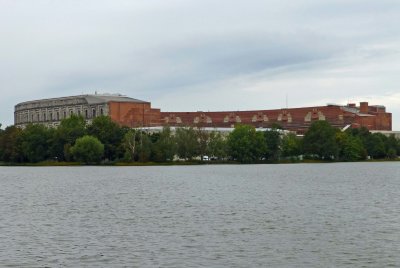
The Kongresshalle was delayed by WWII and only reached about half its planned height of 70 meters |
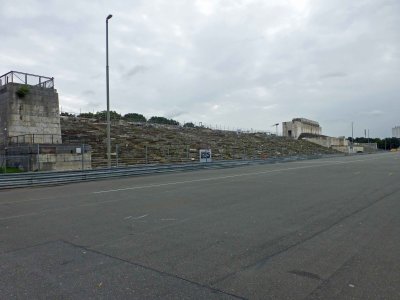
The main grandstands of Zeppelin Field (1935-36) held spectators for parades staged for Adolf Hitler |
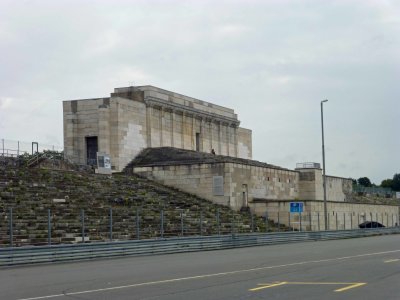
The Steintribune of Zeppelin Field was topped with a giant swastica and was where Hitler gave his speeches |
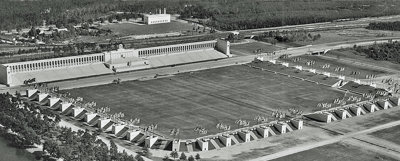
Postcard of Zeppelin Field in 1938 |
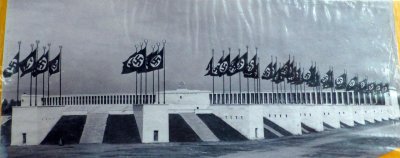
Photo of Nazi flags on 34 small building sdividing seating areas around Zeppelin Field |
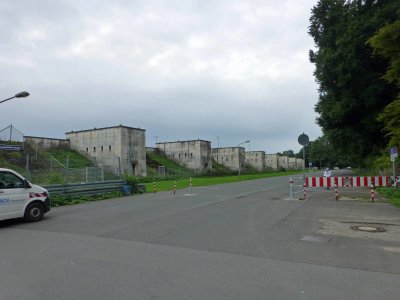
Thirty-four small buildings around the periphery of the Zeppelinfeld were actually toilet facilities |
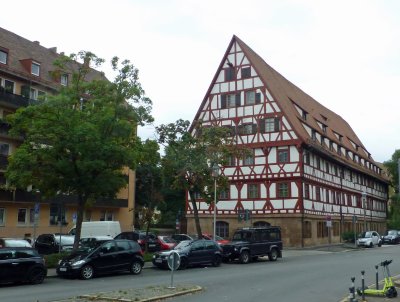
The Weinstadel in Nuremberg was constructed in the 1440s and was used as a hospice and place to feed lepers in the Middle Ages |
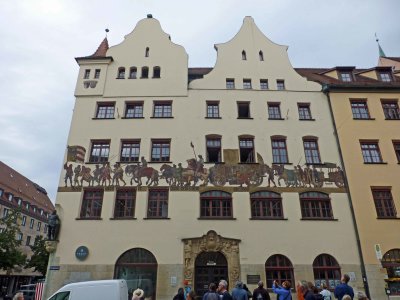
A medieval Nuremberg merchant's procession is depicted on this building that was originally the Nuremberg Stock Exchange |
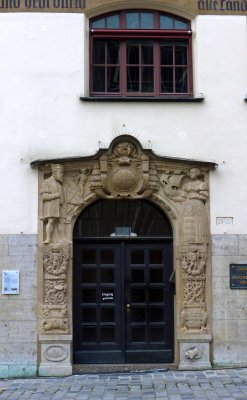
The Old Nuremberg Stock Market building is now part of the Chamber of Commerce |
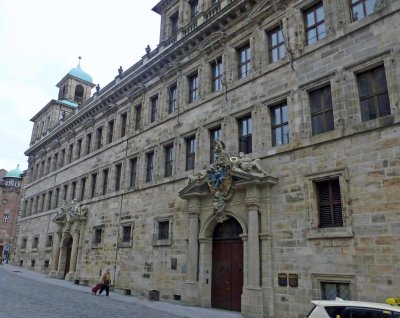
Nuremberg City Hall (1571–1620) was severely damaged during World War II and had to be largely rebuilt in the 1950s |
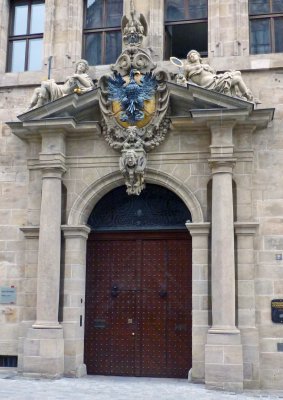
Historic German coat of arms and sculpture over one entrance to Nuremberg City Hall |
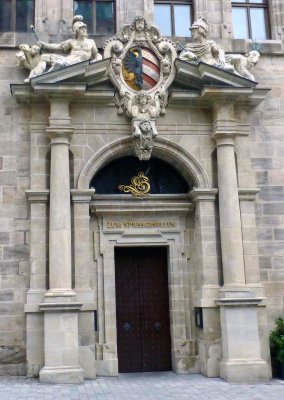
Nuremberg city coat of arms over an entrance to the City Hall |
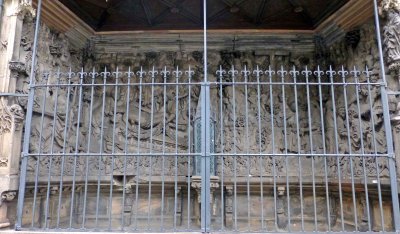
The Schreyer-Landauer Epitaph beside St. Sebald in Nuremberg is a sandstone relief completed by Adam Kraft on Easter 1492 |
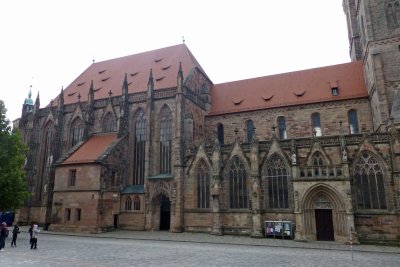
The Church of St. Sebald is the oldest parish church in Nuremberg |
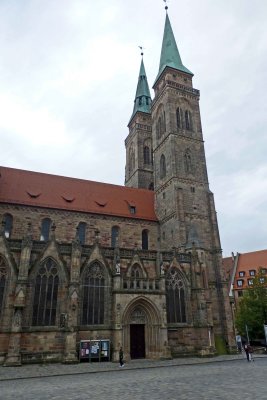
The Church of St. Sebald was founded in 1225, but the towers were added in the 15th Century |
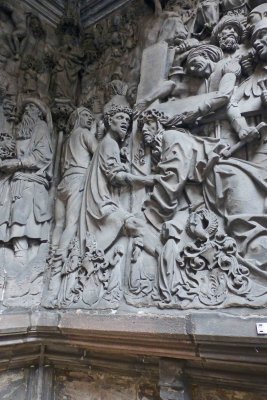
The right panel of the epitaph depicts Jesus carrying a cross among soldiers and onlookers |
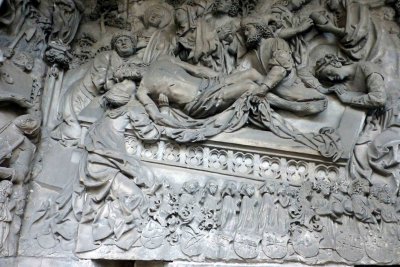
The middle panel shows the burial of Jesus by women, John, Joseph of Arimathea and Nicodemus |
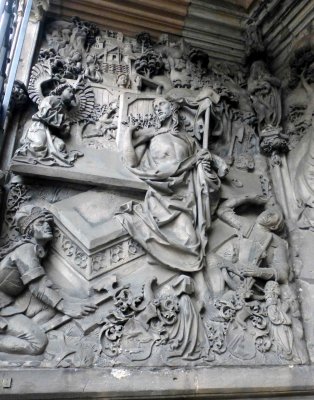
The left panel of the epitath depicts the risen Christ with his victory flag |
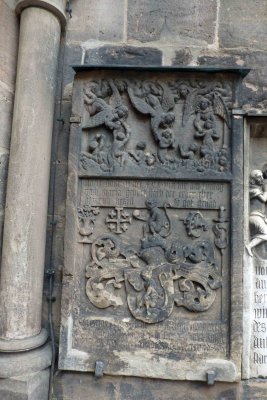
Relief on the side of St. Sebald depicts hell and angels rescuing souls from purgatory |
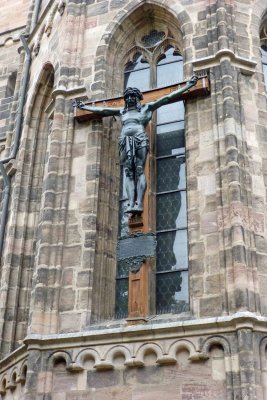
Statue on St. Sebald Church in Nuremberg |
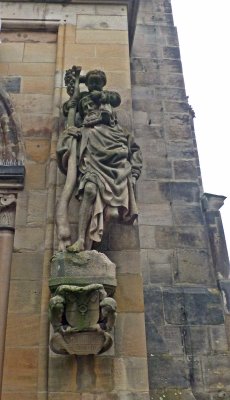
Statue of St. Christopher with the Christchild representing the weight of the world on his shoulders |
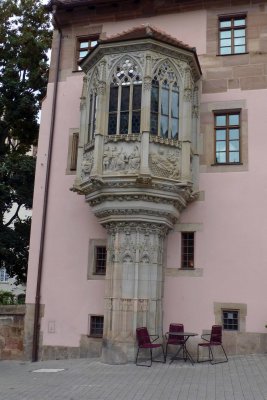
Chorlein (Little Apse) from 1631 at the parsonage of St. Sebaldus Church |

Courtyard of St. Sebald's church parsonage which is still lived in by clergy |
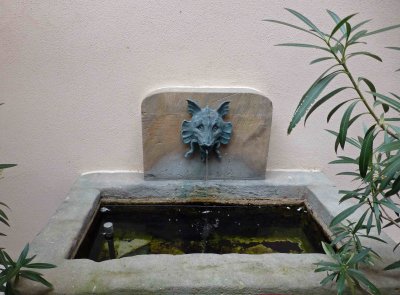
Fountain in the courtyard of the St. Sebald Parsonage |
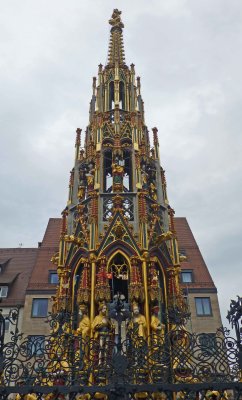
Schoner Brunnen (beautiful fountain) is a 14th-century fountain located on Nuremberg's main market square |
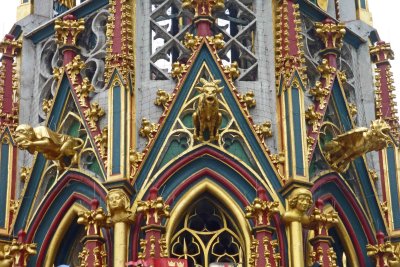
The Nuremberg Fountain was built between 1385 and 1396 |
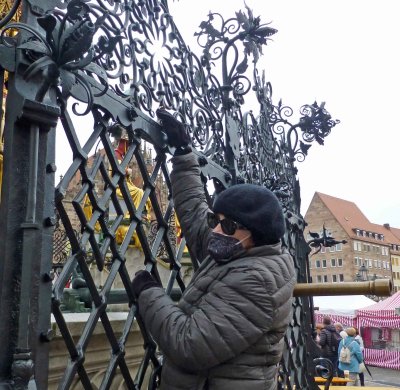
Spinning the gold ring 3 times on the Schoner Brunnen is supposed to grant you a wish |
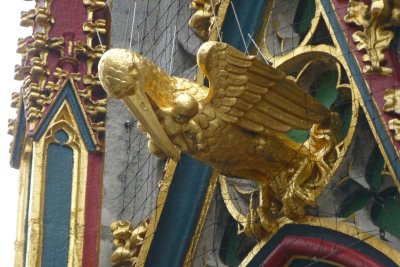
Spinning the black ring 3 times on the Schoner Brunnen is supposed to help you get pregnant |
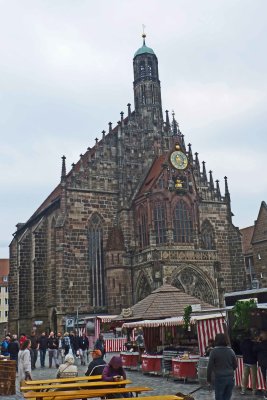
The Church of Our Lady (Frauenkirche) was consecrated in 1358 in Nuremberg, Germany |
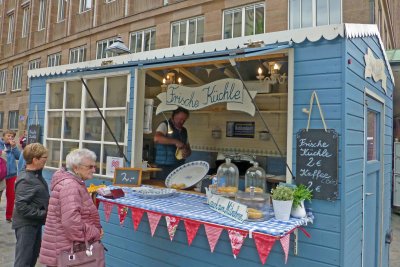
A vendor at a fall market in Nuremberg |
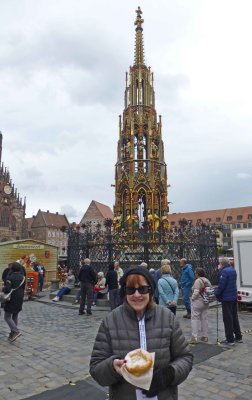
Enjoying deep-fried dough in Market Square in Nuremberg |
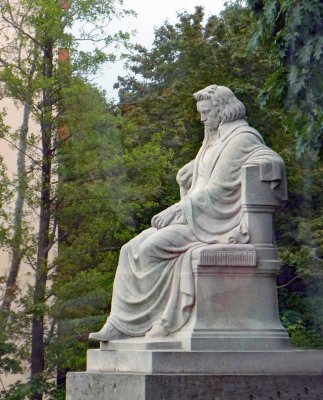
Beethovan Statue in Nuremberg |
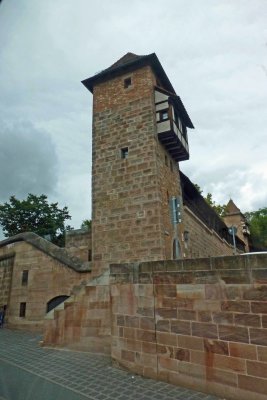
Medieval city walls surround the Old City of Nuremberg |
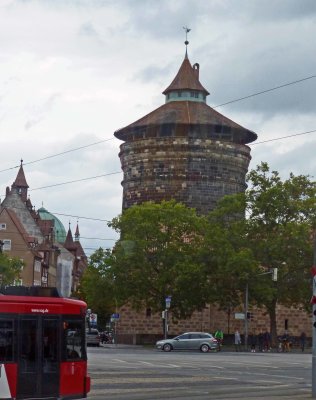
Four gate towers were added to Nuremberg's wall in 1400 |
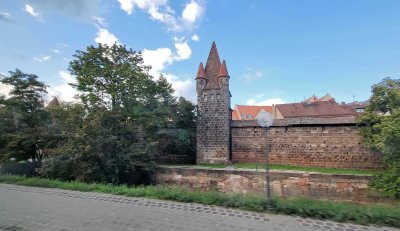
Old city wall in Nuremberg |
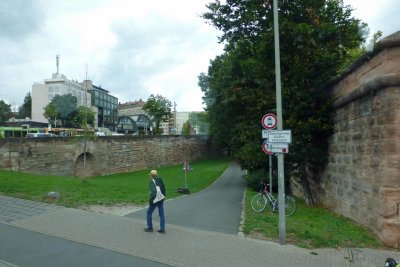
A moat (now containing a walking path) was built in 1430, but never filled with water |
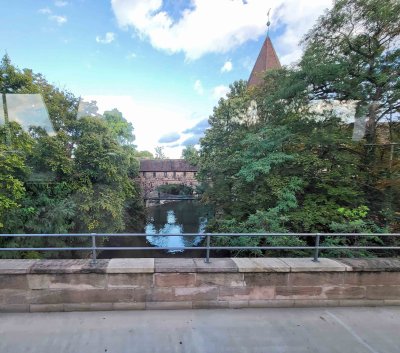
Medieval passage across the Pegnitz River in Nuremberg |
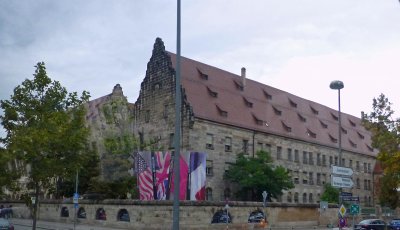
The Nuremberg Palace of Justice (built 1909-1916) |
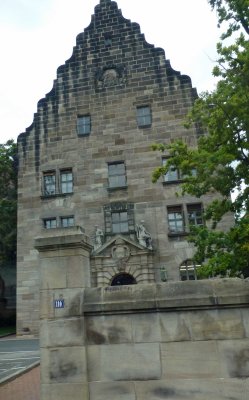
The Nuremberg Trials of Nazi War Criminals were held here beween November 20, 1945 and October 1, 1946 |
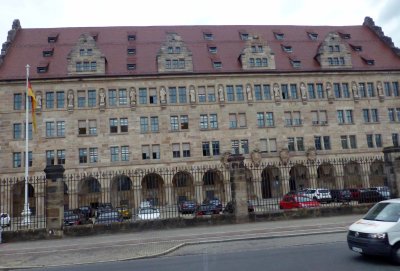
The Nuremberg Trials took place in courtroom number 600 which is still used (especially for murder trials) |
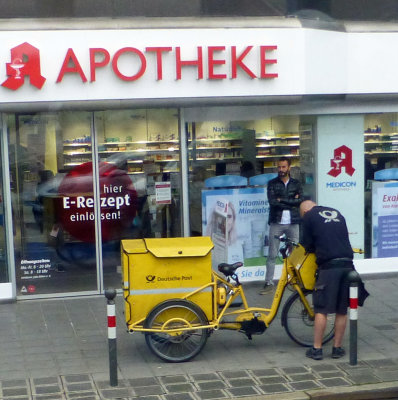
German Postman in Nuremberg |
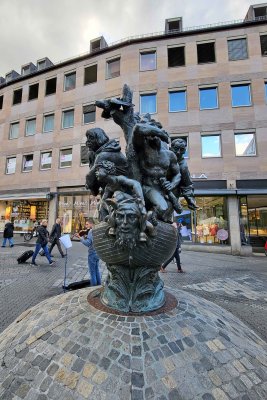
The 'Ship of Fools' dry-fountain sculpture sits in the historical center of Nuremberg |
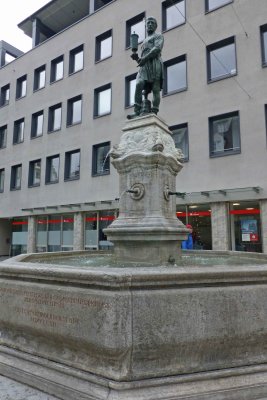
Goldsmith fountain in Martin Luther Square, Augsburg, Germany |
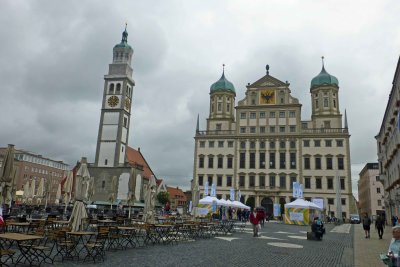
The Town Hall of Augsburg was built between1615–1624 and renovated in the 1980's |
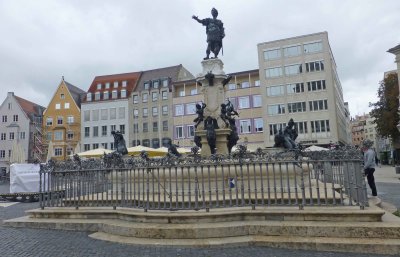
Statue in Augsburg, Germany of city founder and Roman Emperor Augustus (created 1589-1594) |
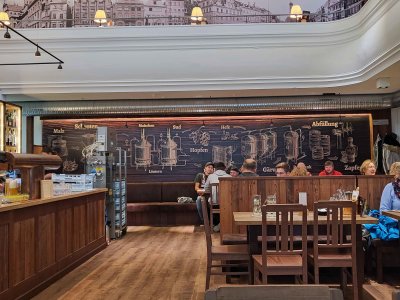
Having lunch at König von Flandern (the oldest restaurant brewery in Augsburg, Germany) |
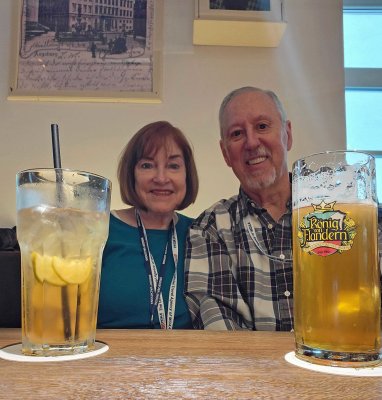
Biggest Caipirinha ever at Konig von Flandern in Augsburg, Germany |
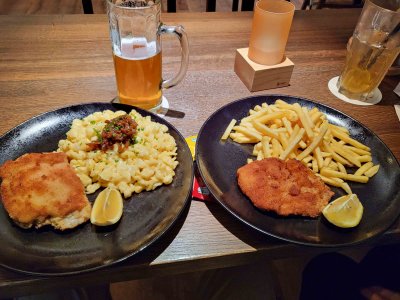
Lots of good German food in Augsburg, Germany |

Driving in the German state of Bavaria |
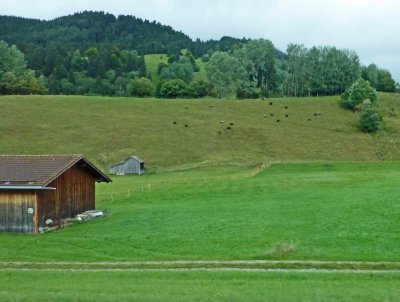
Sheep on a Bavarian hillside |
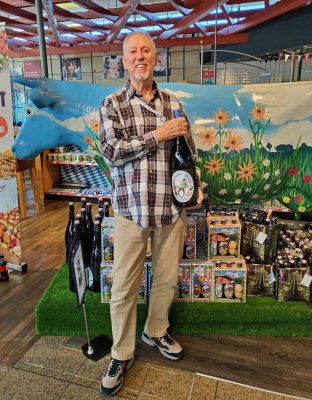
One big beer at a rest stop in Bavaria |
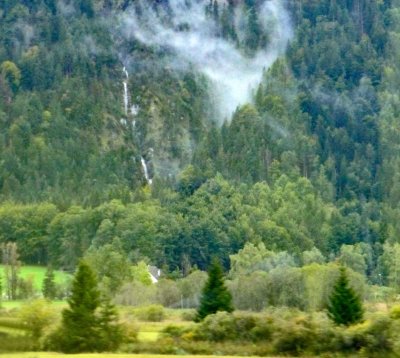
Waterfall in Bavaria |
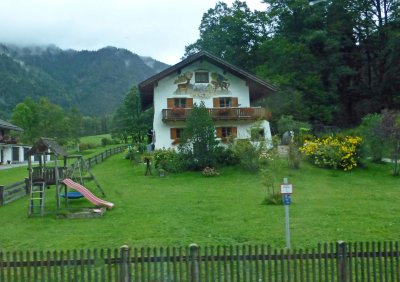
Luftlmalerei is a form of mural art that is native to villages in Bavaria |
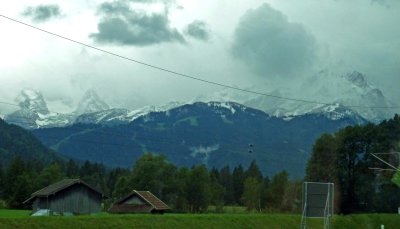
Snow on the Bavarian Alps |
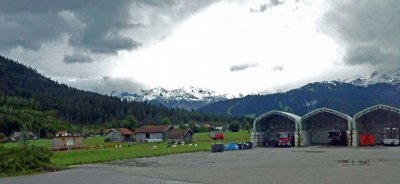
On the road in Bavaria |
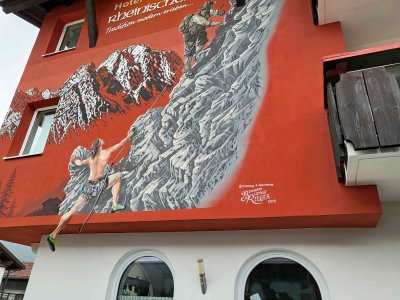
Interesting mural on Hotel Rheinischer Hof in Garmisch-Partenkirchen, Germany |
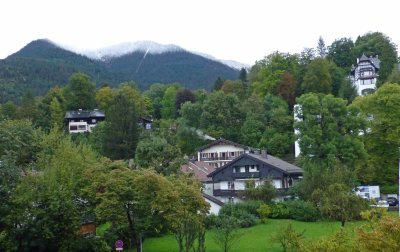
The view from our hotel room in Garmisch-Partenkirchen, Germany |
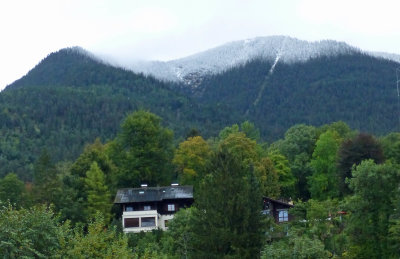
No heat in the hotel yet but the room is not too cold |
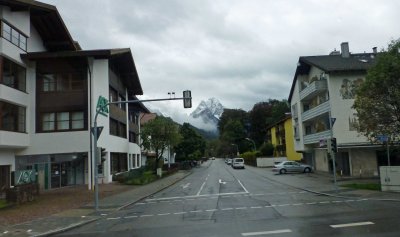
Leaving Garmisch-Partenkirchen for the day |
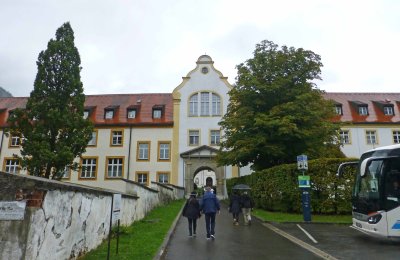
Entering Ettal Abbey (founded on 28 April 1330) in Ettal, Germany |
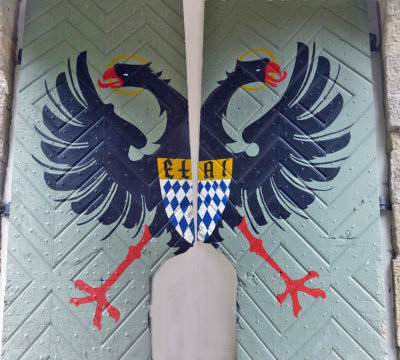
Ettal Abbey doors |
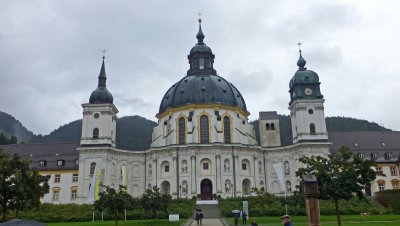
Ettal Abbey is a Benedictine monastery |
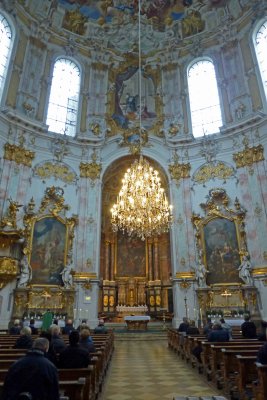
Inside Ettal Abbey Church |
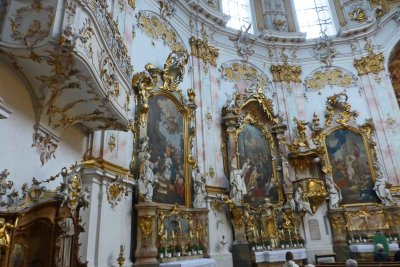
Frescoes in Ettal Abbey Church |
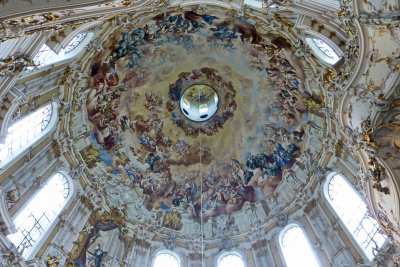
Dome in Ettal Abbey Church |
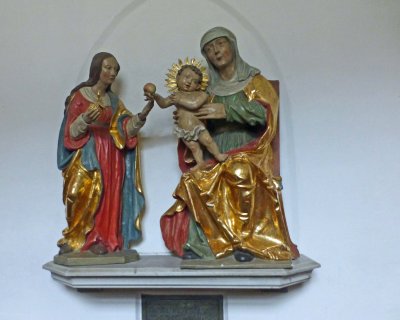
Statue in the Ettal Abbey Church |
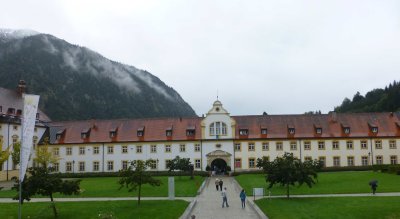
With a community of more than 50 monks, Ettal Abbey is one of the largest Benedictine houses |
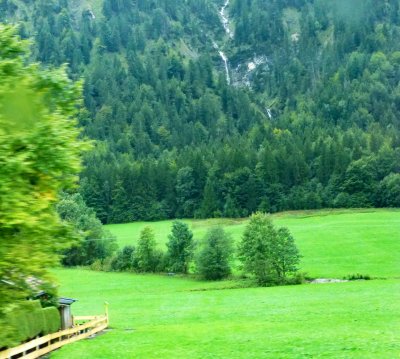
Waterfall in Bavaria is good news for German rivers |
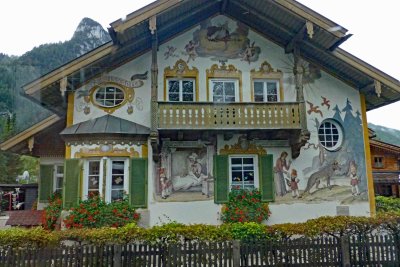
Little Red Riding Hood painted house in Oberammergau, Germany |
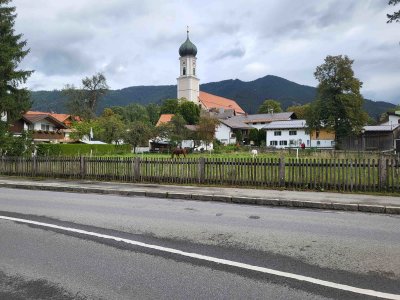
Horses in Oberammergau, Germany |
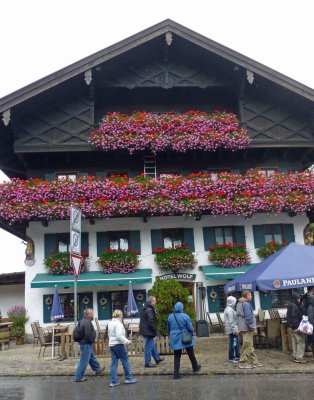
Windowboxes at the Hotel Wolf in Oberammergau, Germany |
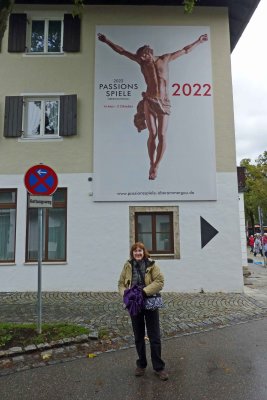
On the way to the Passion Play in Oberammergaus which was postponed from 2020 |
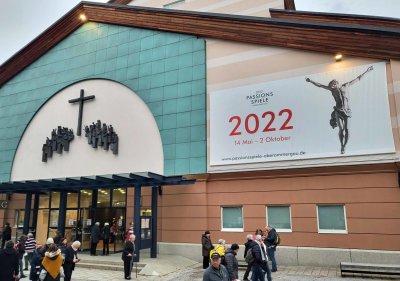
Passion Play Theater in Oberammergau, Germany |
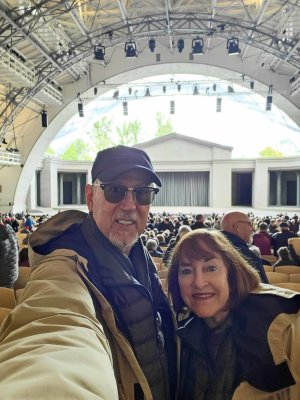
Part one of the Passion Play runs from 1:30 PM to 4 PM |
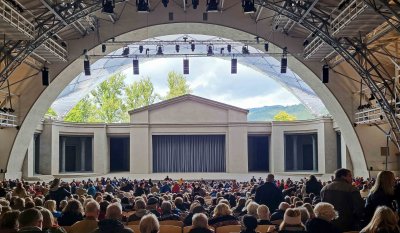
Passion Play Theater holds 4,720 people |
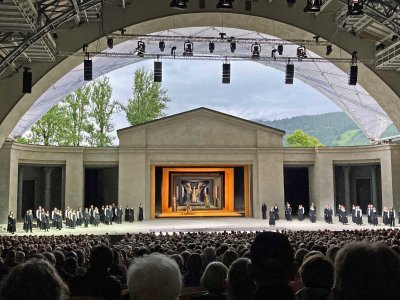
Passion Play has an orchestra of 55 musicians and a choir of 64 vocalists from Oberammergau, Germany |
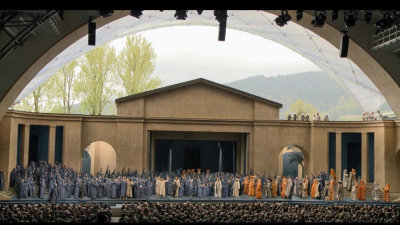
About 2,000 of the permanent residents of Oberammergau participate in the Passion Play |
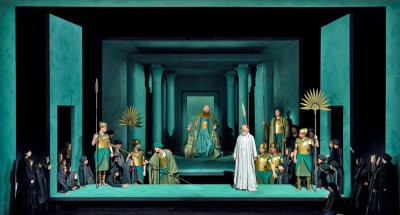
Between each of the 12 acts, Old Testament tableaux vivants are scenes from the Old Testament depicted by motionless actors |
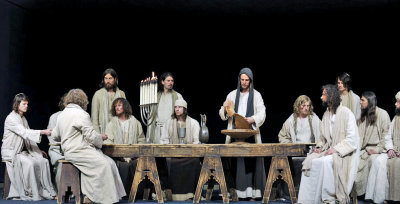
From Ash Wednesday, all participants of the Passion Play must grow their hair and beards |
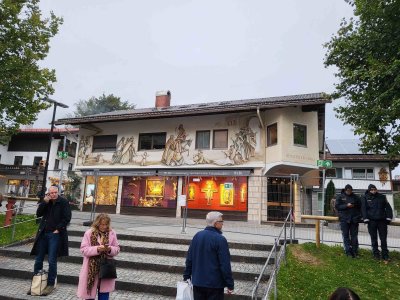
Outside the Passion Play Theater waiting for Susan to clear security for the second half of the performance |
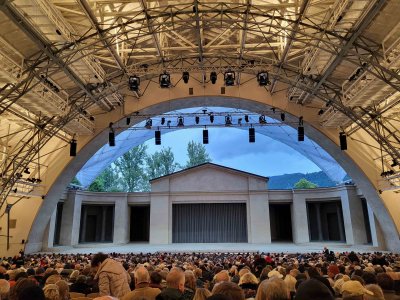
The second half of the Passion Play runs from 7 PM - 9:30 PM |
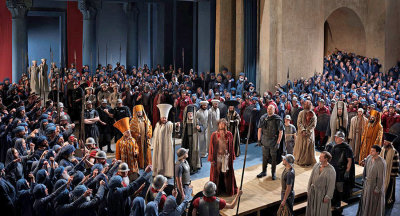
To be in the Passion Play, you must be born in Oberammgau or married to a local for 10 years or have lived there for 20 years |
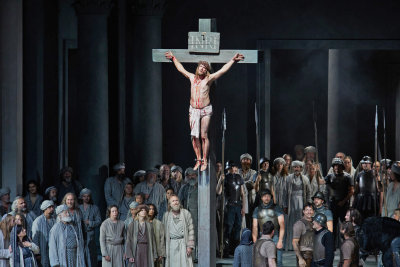
Photos are not permitted during the performance, so most of these are from the internet |
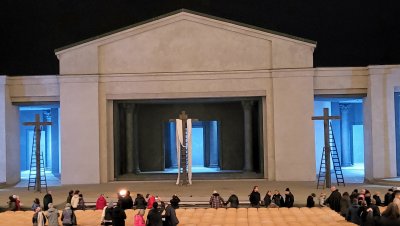
Leaving the Passion Play Theater at 9.45 PM |
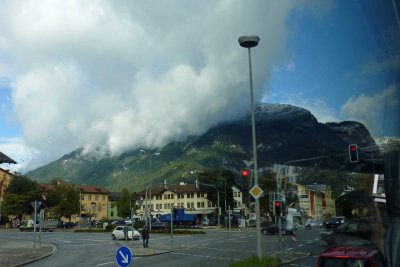
Low-hanging cloud as we are leaving Garmisch-Partenkirchen |
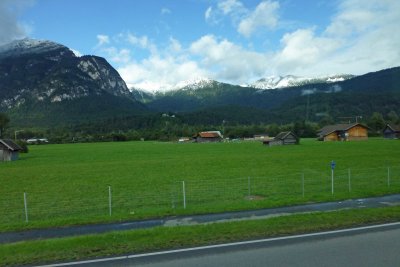
On the road to Munich, Germany |
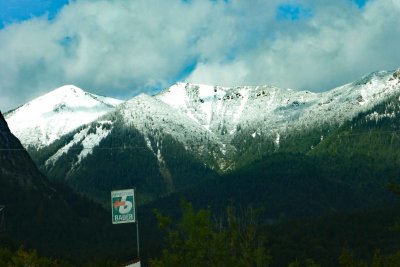
Farewell to the Bavarian Alps |
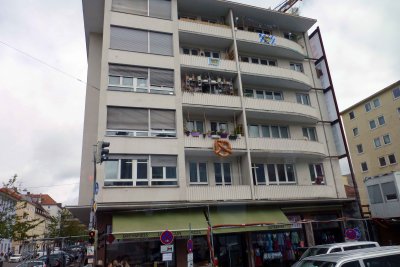
Apartment building in Munich, Germany |
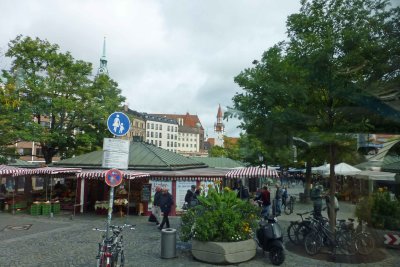
Marienplatz (St. Mary, Our Lady's Square) has been Munich's main square since 1158 |
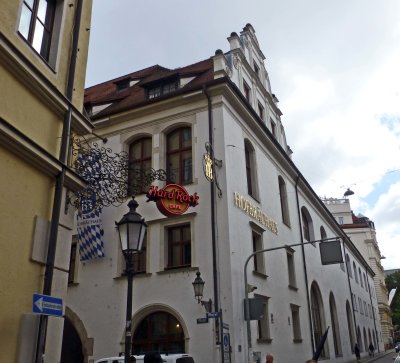
Hofbrauhaus in Munich has been here since 1897 |
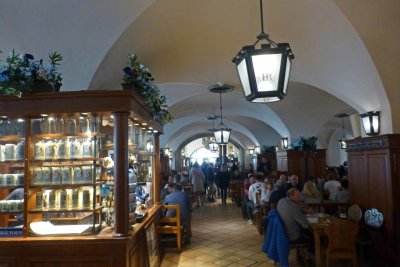
Inside Munich's Hofbrauhaus |
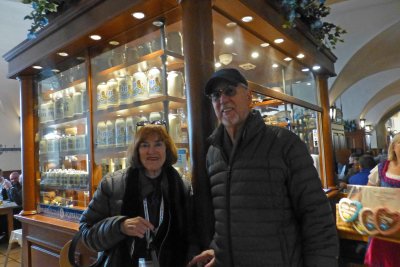
At Munich's Hofbrauhaus |
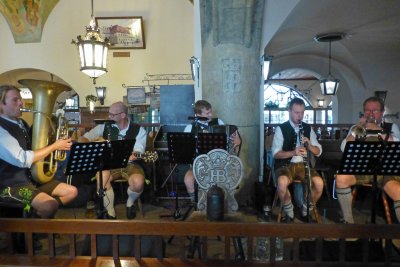
The Hofbrauhaus Oompah Band |
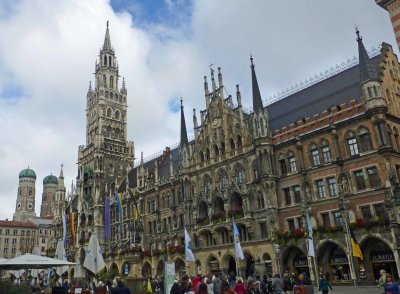
Munich, Germany Town Hall |
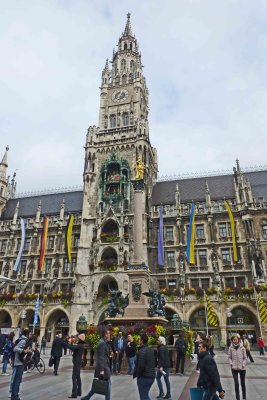
Minimal damage to the Munich Town Hall occurred during the air raids on Munich 1944 |
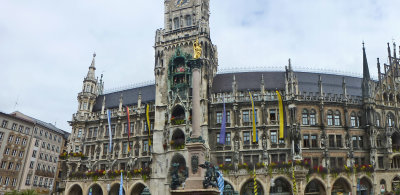
Munich's Rathaus-Glockenspiel has 43 bells and 32 life-sized figures that re-enact two stories from the 16th century |
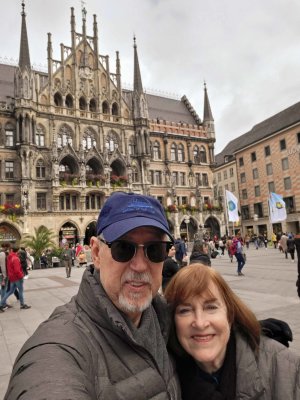
In font of Munich Town Hall |
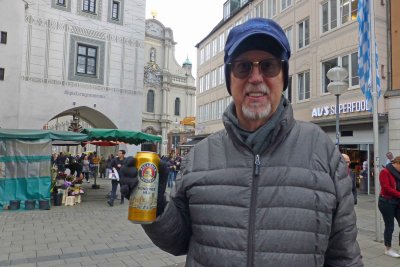
Waiting to re-join our tour group in Munich |
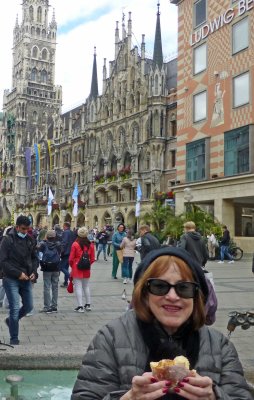
These were great bavarian creme-filled pastries |
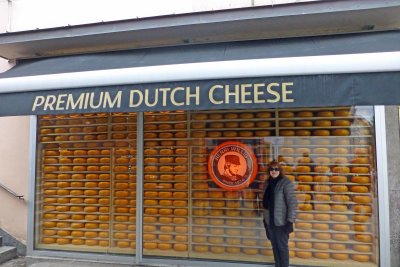
That's a lot of cheese in Munich |
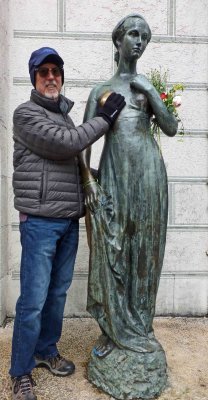
Touching the statue of Juliet's breast is supposed to bring good luck |
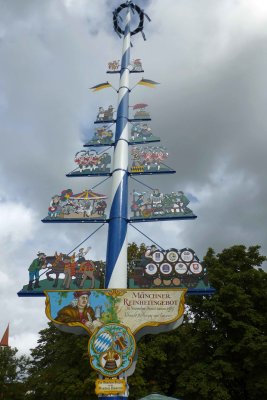
Bavarian Maypole in Marienplatz, Munich, Germany |
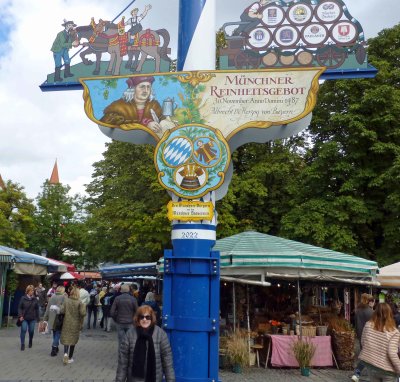
Maypole celebrating the Munich Purity Law that limited the ingredients that could be used in brewing beer |
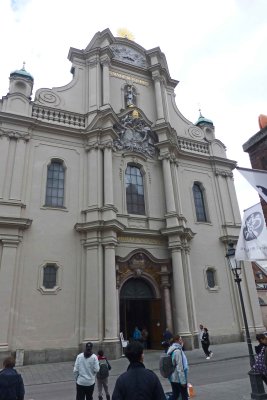
'Church of the Holy Spirit' is one of the oldest churches in Munich (from 1392) |
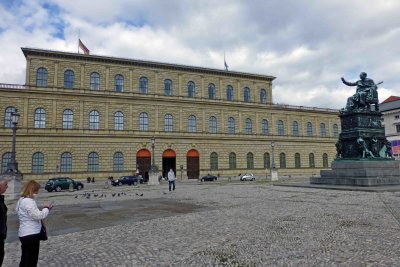
Munich Residence Museum is the former royal palace (1385) of the Wittelsbach monarchs of Bavaria |
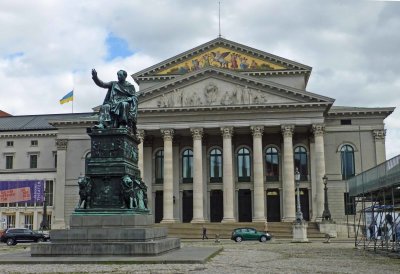
The National Theatre in Munich, Germany, is the home of the Bavarian State Opera, Orchestra & Ballet |
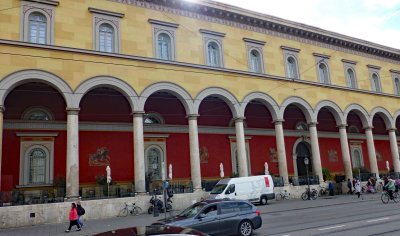
The Hauptpost (Main Post Office) in Munich was erected as the Törring Palace in 1747-58 |
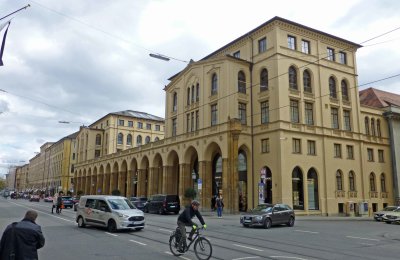
Maximilian street (Maximilianstraße) is one of the main streets of Munich and one of the most expensive streets in German |
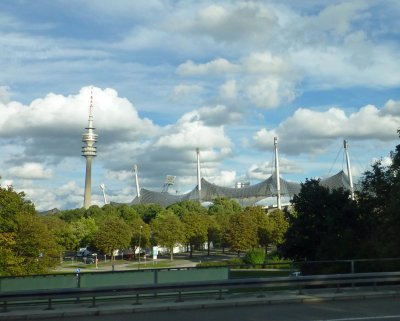
Olympic Tower and Olympic Stadium in Munich were built for the 1972 Summer Olympics |
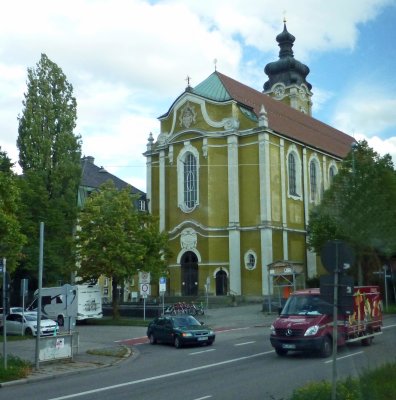
St. Theresia Church in Munich |
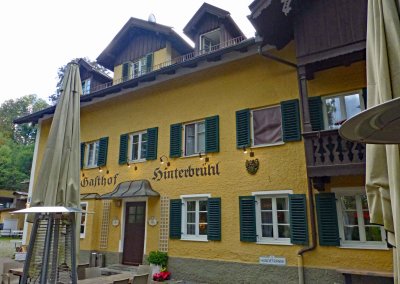
Dinner at the 200-year old Gasthof Hinterbrul in Munich |
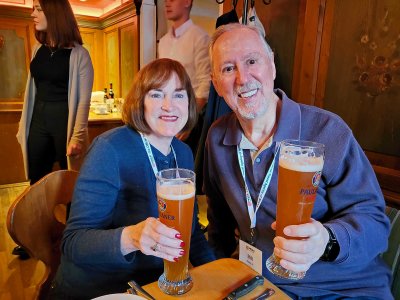
Drinking Wheatbeer at Gasthof Hinterbrul |
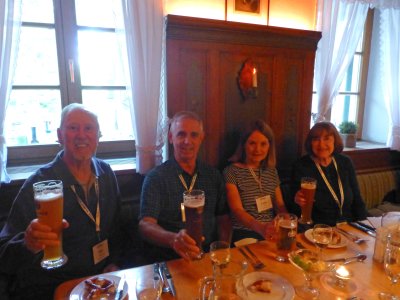
Dinner with Steve & Cindy at Gasthof Hinterbrul |
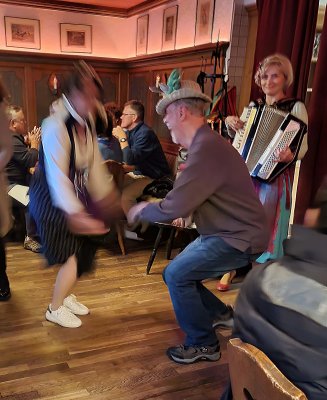
Bill dancing at Gasthof Hinterbrul |
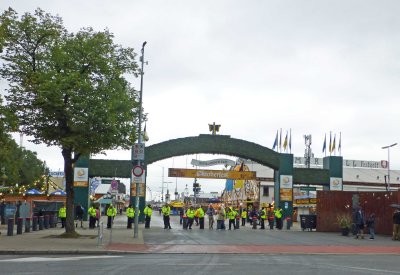
Going to Oktoberfest on a rainy morning |
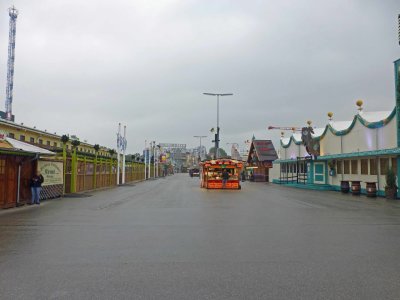
Early, rainy morning at Oktoberfest |
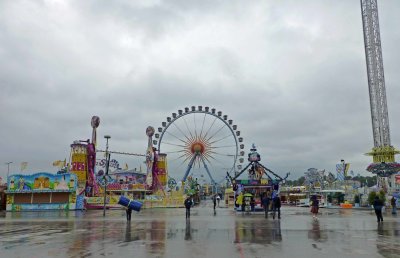
Headed to the amusement area of Oktoberfest |
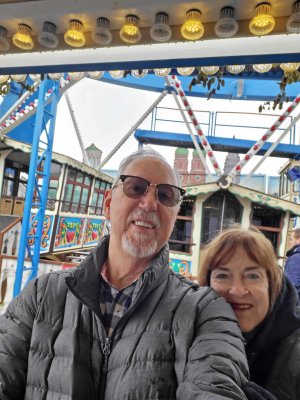
Waiting to board the Ferris Wheel at Oktoberfest |
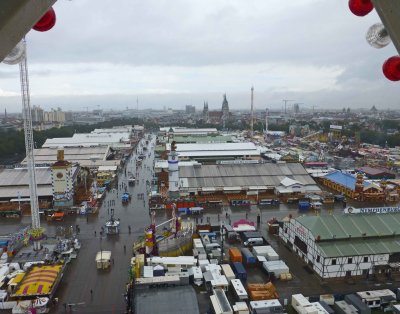
Oktoberfest viewed from top of Ferris Wheel |
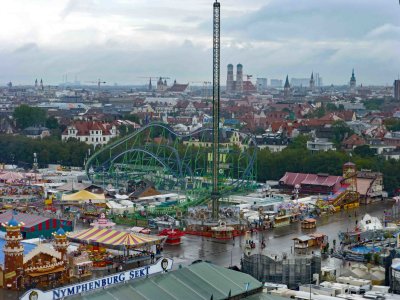
Oktoberfest rides and downtown Munich |
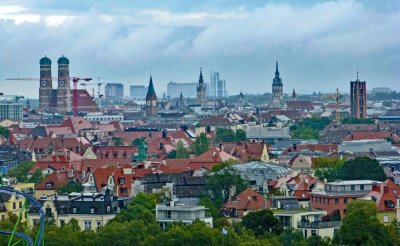
Munich, Germany from the top of the Ferris Wheel |
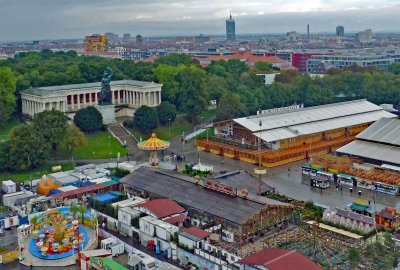
Hall of Fame and Statue of Bavaria sits very close to the grounds of Oktoberfest |
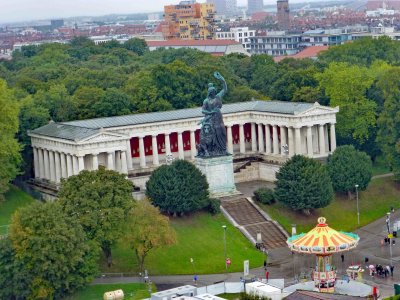
Hall of Fame and Statue of Bavaria was built by King Ludwig I from 1843 to 1853 |
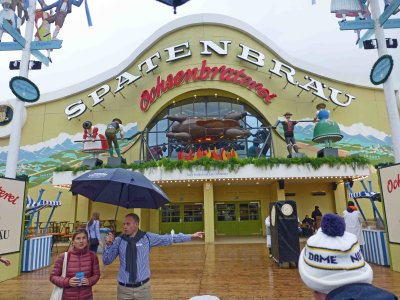
Our first beer tent at Oktoberfest is the Spaten Beer Festhall and Ox Rotisserie Tent |
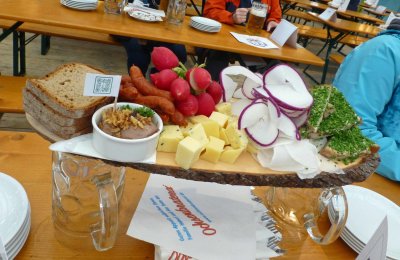
Appetizers at Spaten Beer Ochsenbrateri Tent |
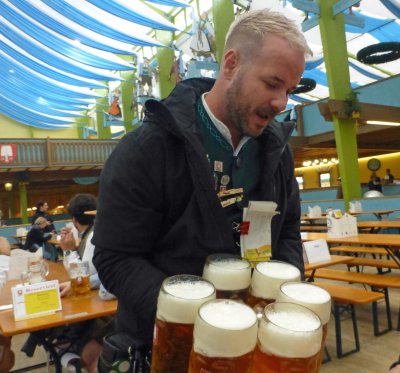
Beer here |
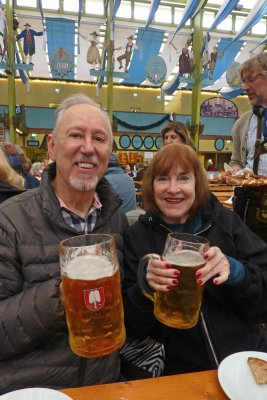
Drinking Spaten Beer |
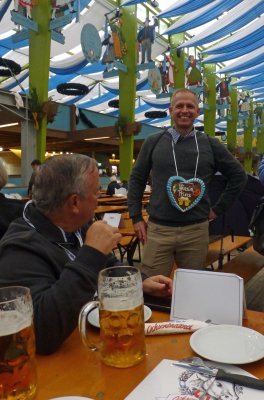
Our tour director, Dan, wearing Lebkuchen at Oktoberfest |
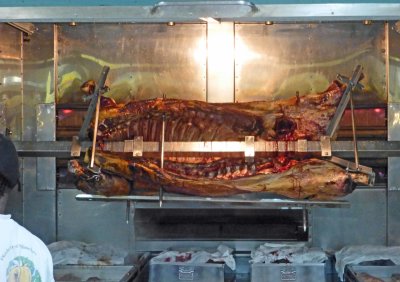
Lunch being cooked on a spit |
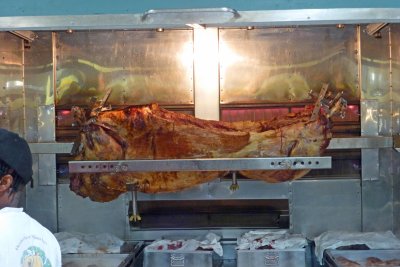
First time seeing an Ox being roasted on a spit |
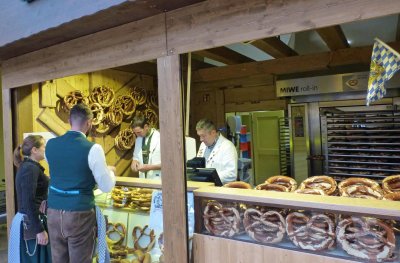
Pretzel vendor in beer tent |
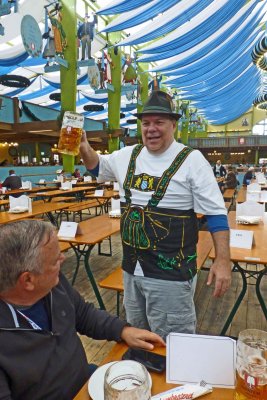
Jon Brenneman is President of MOAA Vacations |
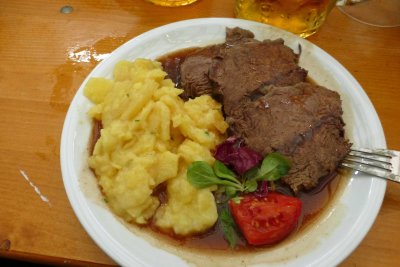
Roast Ox -- it's what's for lunch at Oktoberfest |
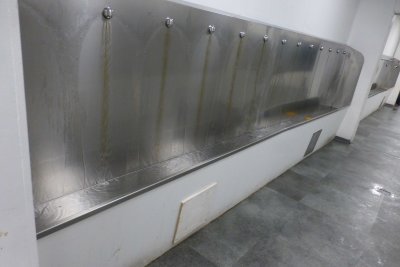
Lots of beer requires lots of places to pee |
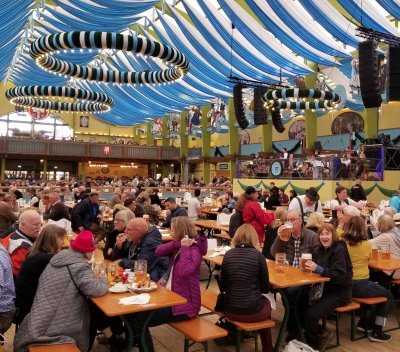
Drinking beer at the Spaten Brau Tent |
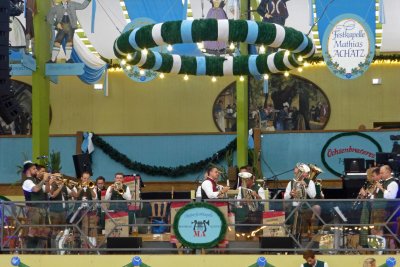
Band at the Spaten Brau Ochsenbrateri Tent |
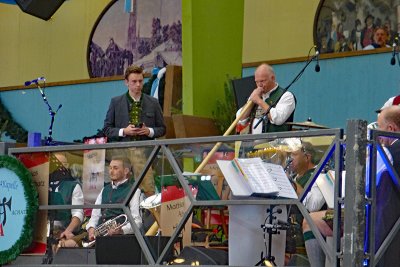
Adding an Alphorn to the band |
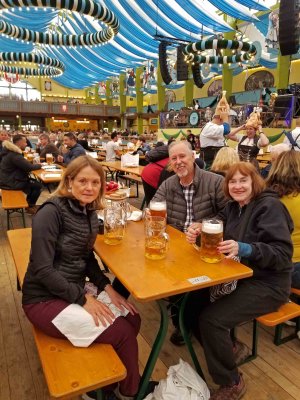
Notice the 'Chicken Dance Hats' behind Susan |
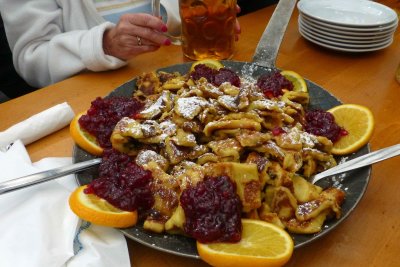
Dessert at Spaten Beer Ochsenbrateri Tent |
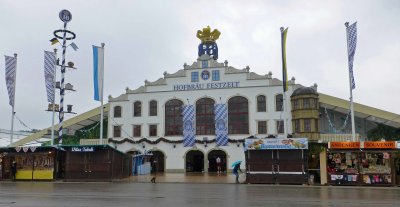
This is translated as 'Hofbrau Party Tent' |
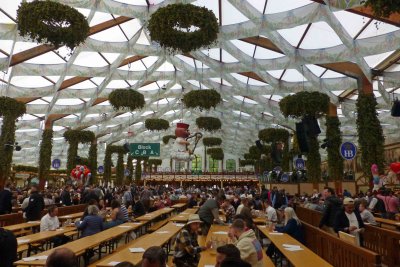
Inside Hofbrau Beer Tent |
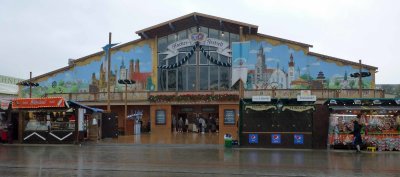
Hacker Beer Tent |
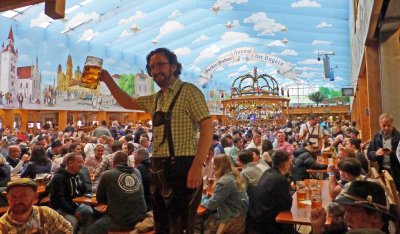
Inside the Hacker-Pschorr Tent |
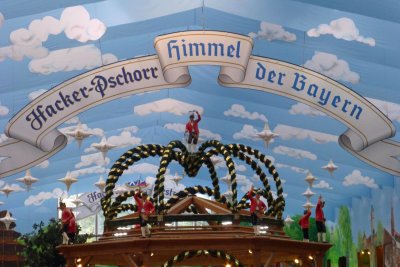
Hacker-Pschorr proclaims itself as 'Heaven of Bavarians' |
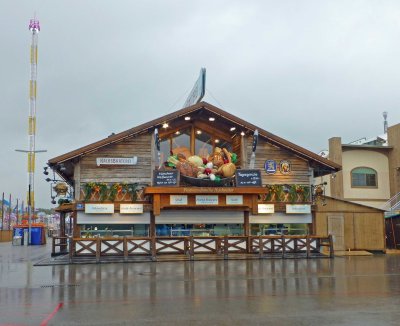
Kalbraterei is a log cabin venue at Oktoberfest |
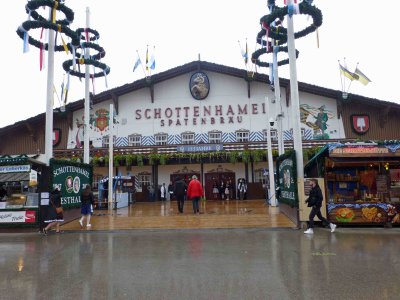
Schottenhamel (est. 1867) is the oldest beer tent at Oktoberfest |
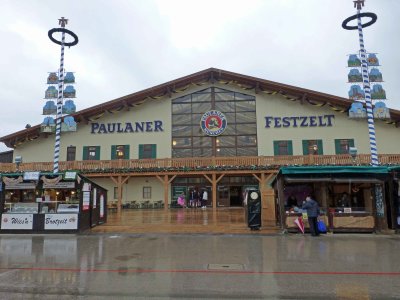
Pulaner Festival Tent |
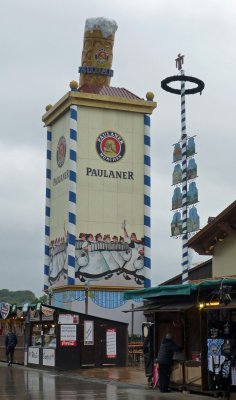
The Pulaner Festival Tower has a rotating beer mug on top |
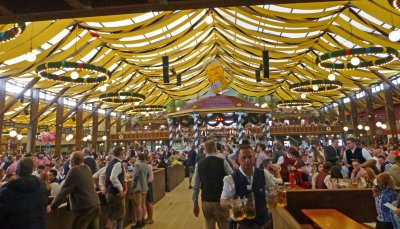
Inside the Pulaner Beer Tent |
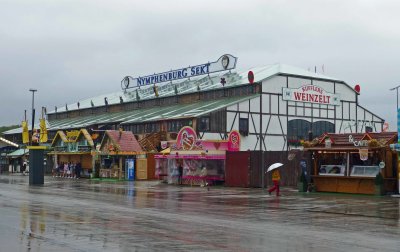
The Weinzelt tent is the only one that focuses on Wine at Oktoberfest |
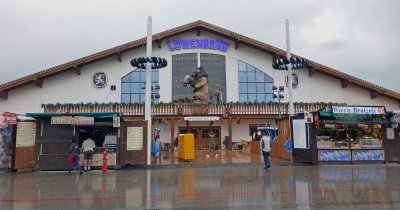
Lowenbrau Festhalle |
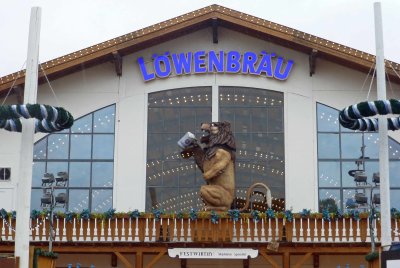
The animated Lowenbrau lion roars and drink his beer |
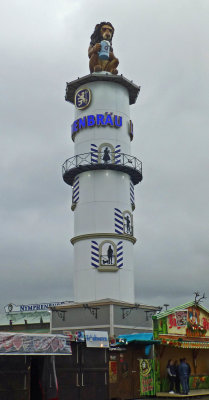
The lion atop the Lowenbrau tower rotates |
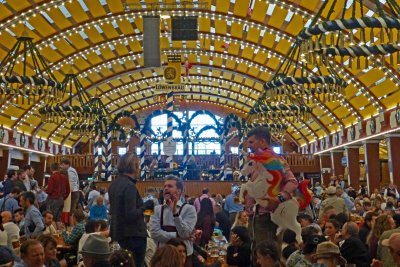
Inside the Lowenbrau Beer Tent |
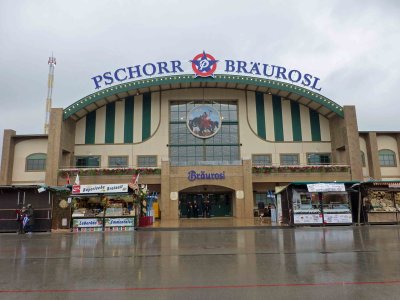
The 'Braurosl' is an artist who yodels in the Pschorr Beer Tent |
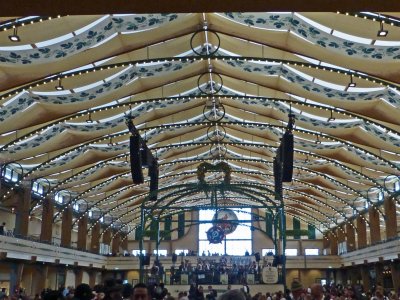
Inside the Pschorr Beer Tent |
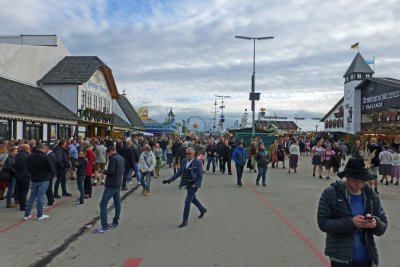
Rain stopped and crowds increasing |
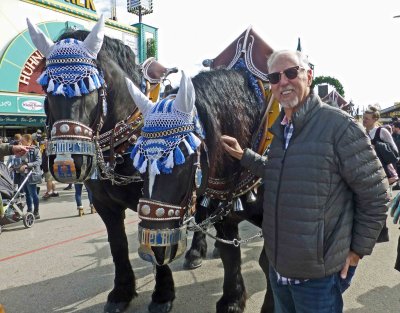
Bill with Augustiner Brewery horses |
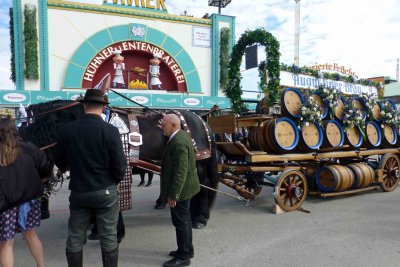
Augustiner Brewery Beer Barrels |
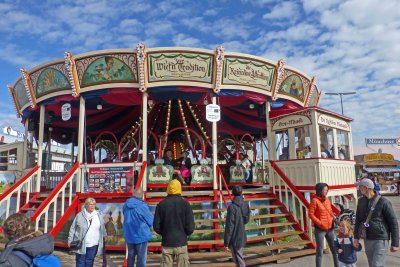
The Krinoline is a historic ride at Oktoberfest (first opened 1924) |
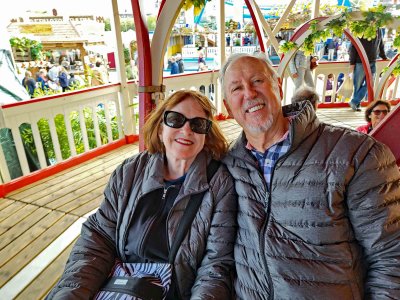
Riding the Krinoline at Oktoberfest |
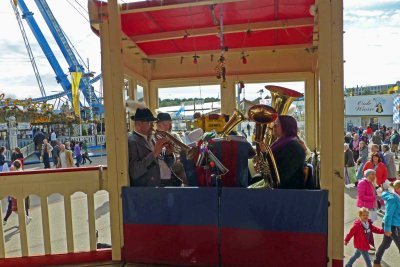
To make the Krinoline more attractive, they added a live band in 1938 |
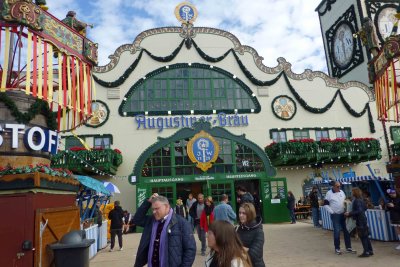
At Augustiner Beer Tent |
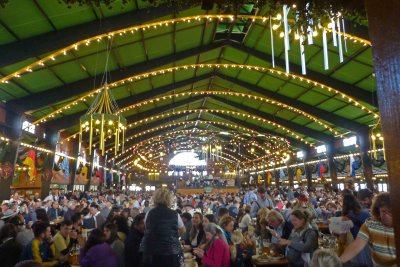
Inside the Augustiner Beer Tent |
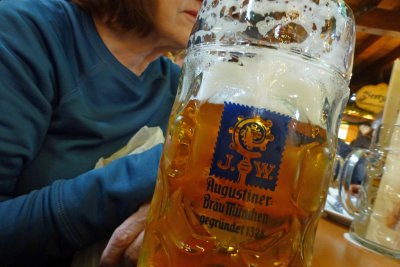
Augustiner Beer is served from wooden barrels with a capacity of 200 liters |
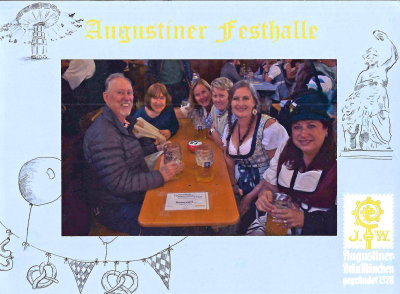
Having fun at Augustiner Beer Tent with new friends from North Carolina |











